- A Beginner’s Guide to IELTS
- Common Grammar Mistakes [for IELTS Writing Candidates]

Writing Correction Service
- Free IELTS Resources
- Practice Speaking Test
Select Page
IELTS Academic Writing Task 1 Types
Posted by David S. Wills | Nov 29, 2021 | IELTS Tips , Writing | 0
For IELTS writing, you will have to do two different tasks, called task 1 and task 2. For task 1, you are required to describe one of 7 different types of visual data:
- A combination of the above
- Process diagram
In this article, we will look at what you would be required to do for those different task 1 types.
Understanding IELTS Writing Task 1
First of all, before we look in detail at any of the above types of data, it is important that we understand what the purpose of IELTS writing task 1 is. I think people normally overlook this, which causes them to make a range of mistakes.
Basically, this part of the exam tests your ability to convey specific information based upon something that you can see. For that reason, you are given different types of visual data to describe.
You can see from the above selection that there are 7 different types of data. Line graphs, bar charts, pie charts, and tables are all relatively similar, requiring you to comprehend and then explain numbers and trends. However, process diagrams and maps are quite different, requiring you to sequence information or explain layouts and describe changes over time.
Importantly, you are not required to talk about your opinion or give any general knowledge. That is something you may have to do for task 2. This is important to know because understanding task 1 puts you in a good position to succeed at it.
Now, let’s look at the different IELTS writing task 1 types.
1. Line Graphs
Probably the most common type of IELTS writing task 1 data is a line graph. As a result, many textbooks, teachers, courses, and classes focus on teaching this above all else, and so most IELTS candidates feel more confident when presented with a line graph than any other kind of data.
However, you should not be complacent. It carries its own challenges and can be difficult to describe. The important thing is to identify the key idea, then recognise and compare (if appropriate) the most important parts.
Most notably, line graphs show changes over time . You can use language like “increase,” “decrease,” “rise, “fall,” and so on to show how values change as time progresses.
Here is a video about IELTS line graphs:
And here are some useful links:
- How to Describe Line Graphs
- Sample Line Graph Description
- The Most Difficult IELTS Line Graph
2. Bar Charts
Perhaps the next most common type of IELTS writing task 1 question asks you to describe a bar chart. This is not the same as describing a line graph, yet many people make the mistake of tackling it in the same way.
Notably, bar charts quite often do not show changes over time and could indicate different values within one month or year. Thus, you must be careful to avoid using inappropriate language when describing these.
As with line graphs, you should look for the highest and lowest values, comparing big differences and focusing on the most significant parts rather than describing all data points.
- How to Describe a Bar Chart
- Sample Answer #1
- Sample Answer #2
3. Pie Charts
These are also quite common in IELTS writing task one. Sometimes you will be given two or more pie charts to compare and sometimes you will be given a pie chart and another kind of data, like a table. The important thing is to figure out what the pie chart reflects, what its values mean, and then convey this accurately to your reader.
Pie charts are often very simple to understand because of the easy way that they convey data. However, they also can be extremely challenging. I have seen some that are quite hard to understand and very hard to describe with any degree of accuracy.
Remember that pie charts are almost always presented as percentages . This is because the whole pie chart adds up to 100%. Approach these carefully by taking a reasonable amount of time to analyse the chart before describing it.
- How to Describe Pie Charts
Tables often look simple but pose hidden challenges. For one thing, most IELTS task 1 tables contain far more information than other kinds of chart, so it is tempting to include more figures in your description. However, keep in mind that this is an English test so you should not cram your essay full of numbers.
As tables are also not a visual medium of conveying ideas, they can require you to think a lot more to draw comparisons. Whereas a bar chart will be easy in terms of finding the highest and lowest value, it is possible to overlook these in a table.
- How to Describe Tables
5. Combinations
It is important to note that you will not always be given a line graph, bar chart, pie chart, or table. In fact, these could appear in any combination. The most common ones that I have seen are tables mixed with pie charts.
This sort of task can be daunting. Where do you begin in describing such mixed data? Well, it totally depends upon the information that you are given. There is no set formula and you will have to think carefully and make choices when it comes to grouping information and creating a task 1 structure.
Sometimes you will need to bring all the information together, but sometimes it is quite clear that the table, for example, should be described as one set of data and the pie chart for another. This will require careful consideration.
Here is an example:
6. Process Diagrams
The next type of task 1 question is a process diagram, which you may also see called a flow chart. I don’t call them “flow charts” because often that is an inaccurate description, although sometimes they are actually flow charts.
Anyway, this will basically be a visual depiction of some sort of process and you will need to describe it. This will be quite different from describing any kind of chart for a few reasons:
- You will not really select things because you will need to describe everything.
- Passive voice is important here to reflect the fact that we don’t know who or what is doing the actions.
- There is no set language here. The vocabulary will depend 100% on the images shown.
For these reasons and more, many IELTS candidates fear process diagrams, but honestly they are easier to do than line graphs and bar charts. The supposedly difficult vocabulary is almost always given to you in the images and you just have to turn it from a noun into a verb, then convert it into passive voice.
- How to Describe a Process Diagram
- 3 Ways to Prepare for Process Diagrams
- 2 Sample Answers
Finally, we come to perhaps the most feared part of IELTS writing task 1 – describing maps! Many people hate this because it requires perhaps the greatest flexibility in English skill. You cannot just say “X increases” or “There was a change in X.”
For maps, we need to have a pretty good vocabulary, as well as highly accurate verb tenses. This latter part is because IELTS maps typically come in pairs, with each map showing a different point in time. If you make a verb tense error, you will convey the wrong meaning.
However, with a little practice, it is actually not that difficult to prepare to describe maps. Fundamentally, there will be nothing outrageously difficult to do here and you just need to provide a coherent description that clearly gives an overview of each map with some important changes highlighted.
- How to Describe Maps
- Advice on Describing Locations
- A Very Difficult Map (video)
For IELTS writing task 1, there are 7 different types of question that you could be given. Whilst some are more common than others, you should be prepared to answer all of them because any of them could be given to you. Do not panic if you see a map or process diagram because, despite what some people say, they are not necessarily more difficult than the others.
Remember the purpose of this part of the test: to ensure that you can give clear descriptions of something that is presented in front of you. You are not being asked to do anything more than that, and it is important to keep that task at the forefront of your mind if you want to succeed.
About The Author
David S. Wills
David S. Wills is the author of Scientologist! William S. Burroughs and the 'Weird Cult' and the founder/editor of Beatdom literary journal. He lives and works in rural Cambodia and loves to travel. He has worked as an IELTS tutor since 2010, has completed both TEFL and CELTA courses, and has a certificate from Cambridge for Teaching Writing. David has worked in many different countries, and for several years designed a writing course for the University of Worcester. In 2018, he wrote the popular IELTS handbook, Grammar for IELTS Writing and he has since written two other books about IELTS. His other IELTS website is called IELTS Teaching.
Related Posts
How to Use More Advanced Vocabulary for Task 1 [IELTS Writing]
October 11, 2017
Describe a Memorable Holiday
June 12, 2018
Skimming and Scanning Practice – UFOs
April 2, 2016
How to Improve your English Vocabulary
January 29, 2019
Leave a reply Cancel reply
Your email address will not be published. Required fields are marked *
This site uses Akismet to reduce spam. Learn how your comment data is processed .
Download my IELTS Books
Recent Posts
- How to Improve your IELTS Writing Score
- Past Simple vs Past Perfect
- Complex Sentences
- How to Score Band 9 [Video Lesson]
- Taxing Fast Food: Model IELTS Essay
Recent Comments
- David S. Wills on How to Describe Tables for IELTS Writing Task 1
- anonymous on How to Describe Tables for IELTS Writing Task 1
- David S. Wills on Writing Correction Service
- James Oluwasegun on Writing Correction Service
- Daisey Lachut on IELTS Discussion Essays [Discuss Both Views/Sides]
- Lesson Plans
- Model Essays
- TED Video Lessons
- Weekly Roundup
Welcome Guest!
- IELTS Listening
- IELTS Reading
- IELTS Writing
IELTS Writing Task 1
- IELTS Writing Task 2
- IELTS Speaking
- IELTS Speaking Part 1
- IELTS Speaking Part 2
- IELTS Speaking Part 3
- IELTS Practice Tests
- IELTS Listening Practice Tests
- IELTS Reading Practice Tests
- IELTS Writing Practice Tests
- IELTS Speaking Practice Tests
- All Courses
- IELTS Online Classes
- OET Online Classes
- PTE Online Classes
- CELPIP Online Classes
- Free Live Classes
- Australia PR
- Germany Job Seeker Visa
- Austria Job Seeker Visa
- Sweden Job Seeker Visa
- Study Abroad
- Student Testimonials
- Our Trainers
- IELTS Webinar
- Immigration Webinar
Share on Whatsapp
Share on Email
Share on Linkedin

Limited-Time Offer : Access a FREE 10-Day IELTS Study Plan!
“Master IELTS Writing Task 1 with this in-depth guide covering structure, question types, expert tips, practice resources with responses, and scoring criteria. “
If you're prepping for IELTS, you've probably realized that Writing Task 1 can be tricky to master. We mean, who enjoys describing graphs and charts, right? However, interpreting visual data and summarizing information accurately is a vital skill for higher education and global communication.
So how do you go about cracking IELTS Writing Task 1? Just follow this detailed guide. We'll explore the structure, different question types, killer tips, band descriptors, and more. We'll also walk you through sample responses so you can start practicing right away. Let's do this!
What is IELTS Writing Task 1?
The IELTS Writing Test has two tasks.
Firstly, IELTS Writing Task 1 Academic specifically checks your ability to analyze visuals like charts, tables, graphs, maps, process diagrams, and so on.
You'll get different types of visual prompts for Academic vs General Training:
IELTS Writing Task 1 Academic deals with visual data representation. The types of IELTS Writing Task 1 questions are:
- Line graphs
Process diagrams
Combination (mixed) charts.
IELTS General Writing Task 1 focuses on everyday functional writing. Question types include:
- Formal Letters
- Semi-Formal Letters
- Informal Letters
In both modules, you get 20 minutes to complete Task 1 in about 150 words. The key assessment criteria are accurate interpretation, clear description, overview of key features, and appropriate style and tone.
How do you structure your response?
We’ll look at both segments of Writing Task 1: Academic & General to answer this question.
IELTS Writing Task 1 Academic
IELTS Writing Task 1 Academic has a 3-step process. Here's a basic scaffolding for approaching any Task 1 question.
IELTS Writing Task 1 structure:
- Paraphrase the chart title, source, and date.
- Describe the main trend(s) in the data in 2-3 body paragraphs ordered logically.
- Close with an overview of the key relationships or patterns.
Let's see how this works with this IELTS Writing Task 1 question - sample bar chart response:
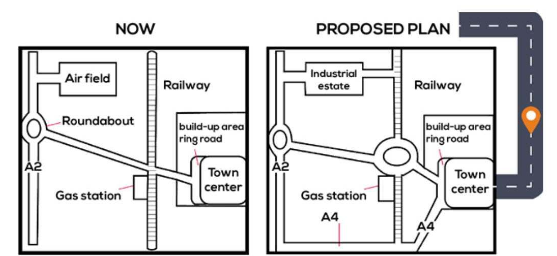
Sample Answer
The map shows the layout of a town currently and a proposed future plan. Overall, the town appears to be becoming more industrialized and connected through additional roads, although much of the existing structures remain unchanged.
In the present-day map, there is an airfield in the northwest that connects to a long north-south road (A2). This road has a roundabout, with another road extending eastwards across a railway line to a gas station. The future plan moves the roundabout southwards slightly and replaces the airfield with an industrial estate, with a new eastward road to the railway line. The railway itself will also be interrupted by a new roundabout near the same gas station.
In the far east of town, there is currently a town center and built-up area around Ring Road, both of which stay the same in the future plan. The proposals add a new road (A4) from the town center along the south edge of town, connecting to A2 in the west. There will also be one more street from the town center allowing passage to the east and north of town.
IELTS Writing Task 1 General
Let’s do the same for IELTS Writing Task 1 General and write a formal letter with proper format and structure. Check the example given below:
Dear Sir/Madam,
I am writing to inform you that I missed my international flight on February 18th due to an issue at the airport. When I arrived to check in, there was an extremely long line at the ticket counter that stretched all the way outside the terminal doors. By the time I reached the counter, it was too late to check in for my flight.
Missing this flight has been very inconvenient, as I had important business meetings scheduled in the destination country. I had to scramble to rebook my travel arrangements and notify my colleagues of the change in plans. This caused unnecessary stress and disrupted my work schedule.
As this was due to circumstances beyond my control, I request that the airline refund the ticket cost or provide a voucher for a future flight. I would greatly appreciate your assistance with this matter. Please let me know if any documentation or additional information is needed from me.
Thank you for your consideration.
[Your name]
What are some key strategies for scoring higher in IELTS Writing Task 1?
We all want to get good grades but do we know - how to get it? Not really. To really ace Task 1, make sure you:
- Use synonyms - Don't just copy words from the prompt. Paraphrase with your own vocabulary.
- Include units of measurement - From the visual like millions, percentage, tons, dollars. This shows attention to detail.
- Highlight obvious contrasts or similarities - Between data trends to make logical comparisons.
- Use linking words - Like "while", "in addition", "on the other hand" to connect your ideas and show cohesion.
- Stick to plain English - Don't try to sound overly complex. Keep your language clear and concise.
Read: IELTS Band Score Calculation
Where can you find awesome practice resources for IELTS Writing Task 1?
You don’t need to go anywhere, we’ve got everything you need:
Below you’ll find some IELTS Writing Task 1 Academic topics followed by IELTS Writing Task 1 General topics. Use the resources as per your requirements.
IELTS Writing Task 1 Maps visually represent geographical data such as locations, distributions, or routes. They provide spatial context and allow for the analysis of patterns and trends across regions.
- Village of Stokeford in 1930 and 2010- Map
- Paradise Island Map – IELTS Academic Writing Task 1 Answers
- IELTS Academic Writing Task 1 Example 4 : Development of the village of Rye mouth – Map
- IELTS Academic Writing Task 1 Topic: The development of cutting tools in the stone age – Diagram
- IELTS Academic Writing Task 1 Example 3: Civic Centre – Map
Table Chart
Tables organize data into rows and columns, making it easy to display exact values.
They are useful for presenting numerical information in a structured format.
Below mentioned are a few examples of Table Chart Task 1. Solve them to get a better idea of Table Chart Task 1:
- Changes in Modes of Travel in England Between 1985 and 2000- IELTS Writing Task 1 (Table)
- IELTS Academic Writing Task 1: Main Reasons why Agricultural Land Becomes Less Productive
- Cinema Viewing Figures for Films by Country, in Millions- Table
- Number of Medals Won by the Top Ten Countries in the London 2012 Olympic Games- Table
- IELTS Academic Writing Task 1 Topic 12: Internet use in six categories by age group – Table
Bar Graph Task 1 displays data using rectangular bars with lengths proportional to the values represented. They are useful for comparing different categories or items side by side.
Below mentioned are a few examples of Bar Graph Task 1. Solve them to get a better idea of task 1 bar chart:
- IELTS Academic Writing Task 1 Topic : Annual pay for doctors and other workers – Bar chart
- Division of Household Tasks by Gender in Great Britain- Bar Graph
- IELTS Academic Writing Task 1 Topic 11: Different methods of waste disposal in four cities – Bar Chart
- Amount of Leisure Time Enjoyed by Men and Women of Different Employment Statuses- Bar Chart
- Number of Computer and Internet users in Different Arab Countries- Bar Graph
Line Graphs
Line Graph Task 1 depicts trends over time using data points connected by straight-line segments. They effectively show continuous data and allow the visualization of rises and falls.
Below mentioned are a few examples of Line Graph Task 1. Solve them to get a better idea of Line Graph Task 1:
- The Changes In Ownership Of Electrical Appliances And Amount Of Time Spent Doing Housework In Households – IELTS Writing Task 1
- IELTS Academic Writing Task 1 Topic : The Percentage of Female Members of Parliament in 5 European Countries
- IELTS Writing Task 1 – The graph below shows different sources of air pollutants in the UK Sample Answers
- IELTS Academic Writing Task 1 Topic: Price changes for fresh fruits and vegetables – Line Graph
- Demand for Electricity in England- Line Graph and Pie Chart
Pie charts are circular charts divided into slices, with each slice representing a category. They illustrate the proportional size of categories in relation to a whole.
Below mentioned are a few examples of Pie Chart Task 1. Solve them to get a better idea of Pie Chart task 1:
- Average Household Expenditures in a Country in 1950 and 2010- Pie Chart
- Methods of Transportation for People Traveling to a University – Pie Chart
- Percentage of Water Used for Different Purposes in Six Areas of the World- Pie Chart
- Online shopping sales for retail sectors in Canada – IELTS Writing Task 1 Pie chart
Process diagrams use a sequence of steps or stages to illustrate a procedure or workflow. They clarify the order and relationships between different components of a process.
- IELTS Academic Writing Task 1 Topic 09 : Consequence of deforestation – Flow Chart
- Academic IELTS Writing Task 1 Recycling process of wasted glass bottles Sample Answers
- Water Cycle Diagram – IELTS Academic Writing Task 1 Answers
- IELTS Writing Task 1 Process Chart 2024 – Process Diagram with Sample Answers
Combined charts integrate two or more chart types, such as bars and lines, into a single visualization. They enable the comparison of different but related data sets within the same chart space .
- Percentage of Food Budget the Average Family Spent on Restaurant Meals- Pie Chart + Line Graph
- Amount of Money Per Week Spent on Fast Food in Britain- Bar Graph + Line Graph
- Water use Worldwide and Water Consumption- Line Graph and Table
Formal Letter
- Formal Letter to Change Hostel Room- IELTS Writing Task 1
- IELTS General Writing Task 1 – Sample Formal Letters
- You Have Seen an Advertisement for a Community College- Formal letter
- Last Week You Were on a Flight to London- Formal Letter
- One of Your Friends Wants to Apply for a Job- Formal letter
Semi Formal Letter
Informal letter, what are the ielts band score standards.
IELTS Writing Task 1 has a scoring standard on the basis of which an answer is evaluated and checked by the board. These are standardized measures that a student needs to follow throughout their answer. Check the tables given below:
IELTS Writing Task 1: Task Achievement and Task Response ( Task 1 & Task 2)
Ielts writing task 1: coherence and cohesion, ielts writing task 1: lexical resource.
Want to ace your IELTS writing?
Book a free trial & talk to our Experts!
IELTS Writing Task 1: Grammar Range and Accuracy
Ielts writing task 1 video to watch.
We have listed down videos that are a must-watch for all the aspirants. This way you can pick up your learning pace with distinct visuals. Check the videos below:
- Understanding IELTS Writing Task 1 ACADEMIC in 20 Minutes
- IELTS Academic Writing Task 1 | BAND 9 MAP Vocabulary 2024
- IELTS Academic Writing Task 1 - TABLE Description | BAND 9 TIPS
- IELTS Academic Writing Task 1 - BAND 9 LINE GRAPH VOCABULARY
- IELTS PIE CHART Writing Task 1 Academic | Band 9 Vocabulary Questions
- IELTS 2024 General Writing Task 1 (COMPLETE) with BAND 8+ SAMPLE LETTERS
Phew, we've covered a lot of ground here. Just remember to analyze the chart carefully, describe the key trends in structured paragraphs, and summarize the main points. Apply the tips and resources suggested above to amplify your Task 1 practice. This will help develop the techniques and vocabulary you need to describe data accurately within the time limit.
Now you've got this - go show the IELTS Writing Task 1 who's boss!
Feeling anxious about your IELTS writing task 1 exam? Book a free webinar with our IELTS writing expert to identify your strengths and weaknesses. Take the first step towards success - book your free seat today !
Frequently Asked Questions
Should I write in full sentences or bullet points?
How do I describe increases and decreases in data?
What if I finish early, can I move to Task 2?
Can I give my opinion or interpretations of the data?
How do I manage my time for Task 1?
Is it OK to just describe and not compare data sets?
Can I use "I" or "we" in my response?
Is it fine if I go way under or over the 150 word target?
Do spelling mistakes affect my score?
How do I avoid going off topic or getting sidetracked?
Practice IELTS Writing Task 1 based on report types
Recent articles.

Raajdeep Saha
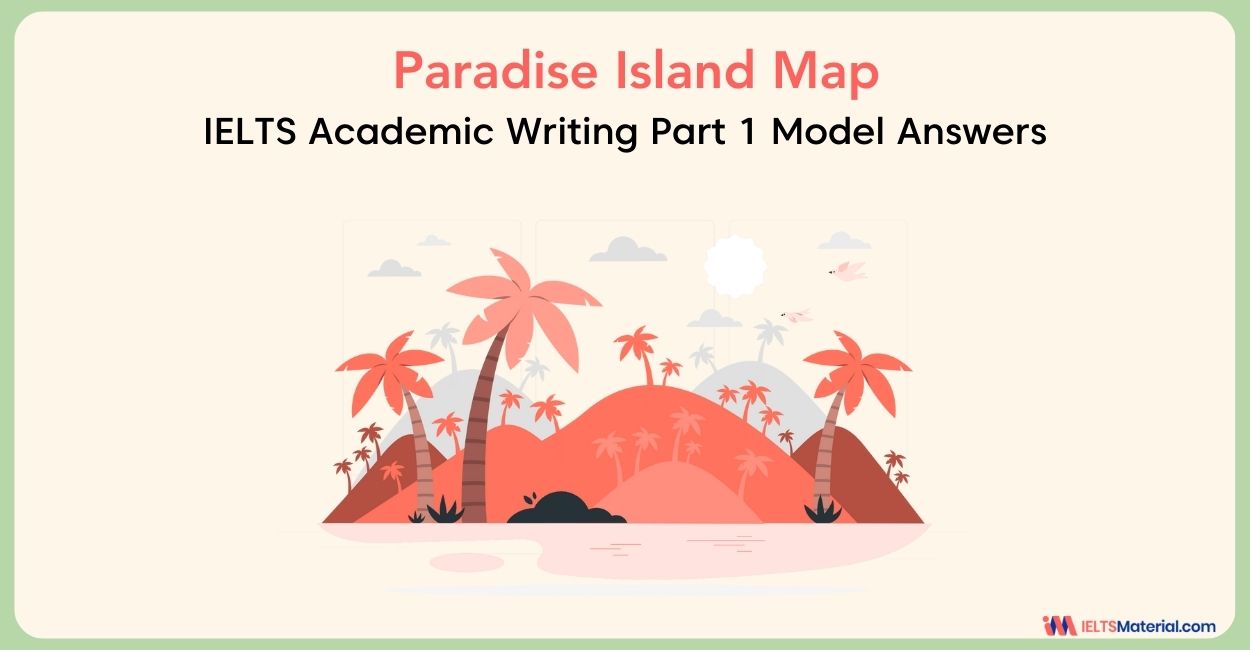
Kasturika Samanta
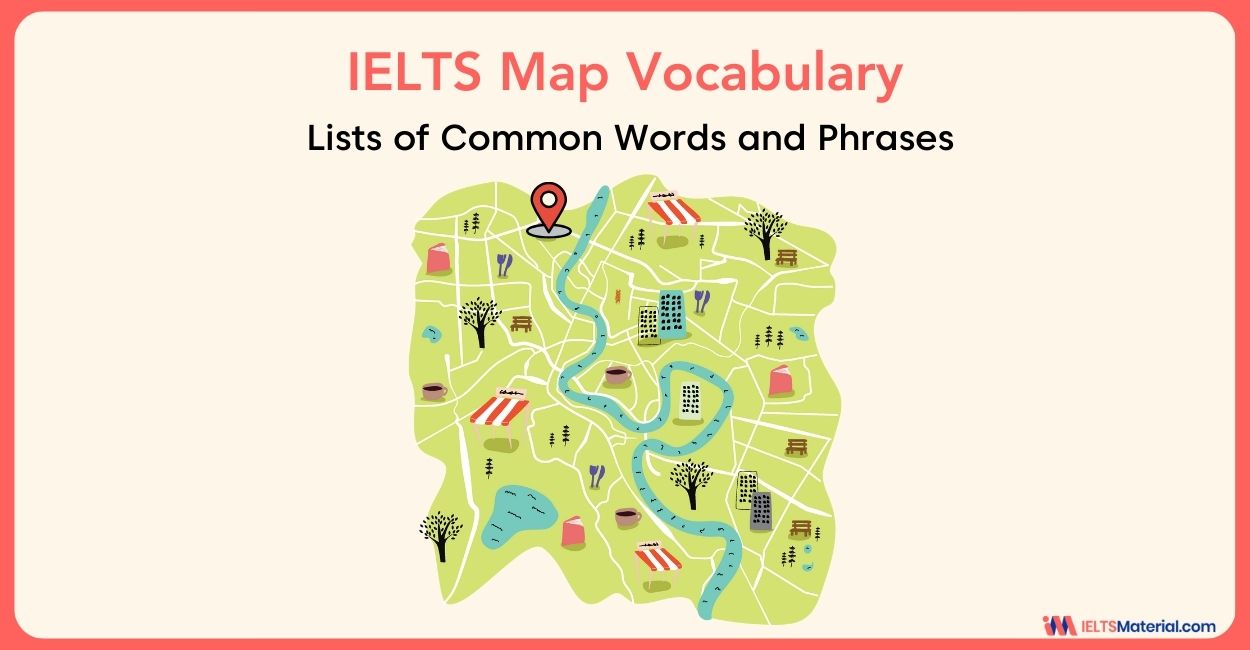
Our Offices
Gurgaon city scape, gurgaon bptp.
Step 1 of 3
Great going .
Get a free session from trainer
Have you taken test before?
Please select any option
Get free eBook to excel in test
Please enter Email ID
Get support from an Band 9 trainer
Please enter phone number
Already Registered?
Select a date
Please select a date
Select a time (IST Time Zone)
Please select a time
Mark Your Calendar: Free Session with Expert on
Which exam are you preparing?
Great Going!
The official IELTS by IDP app is here! Download it today.
- IELTS tests IELTS Academic IELTS General Training IELTS UKVI IELTS One Skill Retake LEARN ABOUT THIS TEST What is IELTS Academic? How can I book an IELTS test? Reschedule or cancel an IELTS test Find sessions WAYS TO TAKE IELTS ACADEMIC IELTS on paper IELTS on computer IELTS Online LEARN ABOUT THIS TEST What is IELTS General Training? How can I book an IELTS test? Reschedule or cancel an IELTS test Find sessions WAYS TO TAKE IELTS GENERAL TRAINING IELTS on paper IELTS on computer LEARN ABOUT THIS TEST What is IELTS UKVI? How can I book an IELTS test? Reschedule or cancel an IELTS test Find sessions WAYS TO TAKE IELTS UKVI IELTS on paper IELTS on computer LEARN ABOUT THIS TEST What is IELTS One Skill Retake? How can I book an IELTS test? Reschedule or cancel an IELTS test READ MORE ABOUT IELTS ONE SKILL RETAKE Who accepts IELTS One Skill Retake? FIND THE RIGHT TEST IELTS for study IELTS for work IELTS for migration
Get your results
Check your provisional IELTS results online and do more.

IELTS Writing Task 1 question types: A comprehensive guide
This comprehensive guide breaks down the different question types in the Writing Task 1 section, including graphs, bar charts, pie charts, tables, and maps.
Content Tags
In the IELTS Writing test, there are a variety of question types you can receive. It is important to have a look at these so you don’t have any surprises when you sit your test.
In Task 1 of the IELTS Writing Academic test, you have visual items, such as graphs and charts, and you are expected to provide a description of them, including data, comparison and contrasts and an overview.
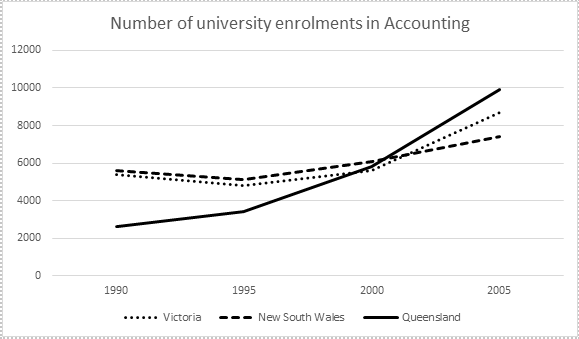
It is common to see diagrams like this which indicate the number, percentage or rate of something over a period of time. In this case, the time span is over 15 years and there are 3 separate lines (categories). Line graph tasks can include 2,3, 4 or possibly up to 6 lines in the whole chart.
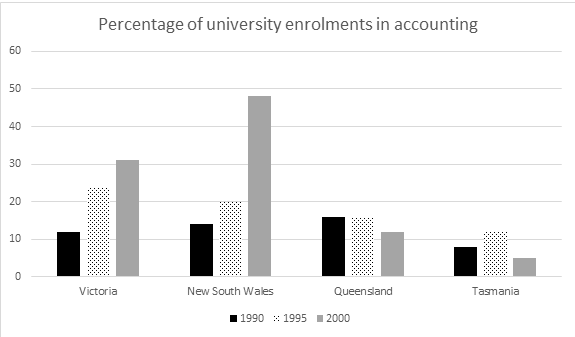
Similar to line graphs, bar charts can also display data in a linear way (e.g. from 1990 to 2000 in this case). However, data can also be categorised in a non-linear way such as below:
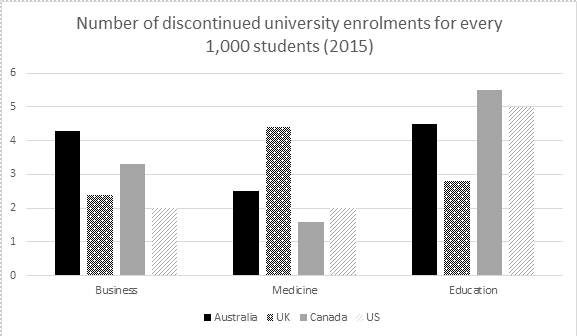
Pie charts normally have figures displayed in percentages and it is common to see tasks where there are 2 or more of them. Similar to bar graphs, they can be categorised in linear or non-linear ways.
The charts below show the percentage of second language classes taken by Australian secondary school students in two different cities in 2017.
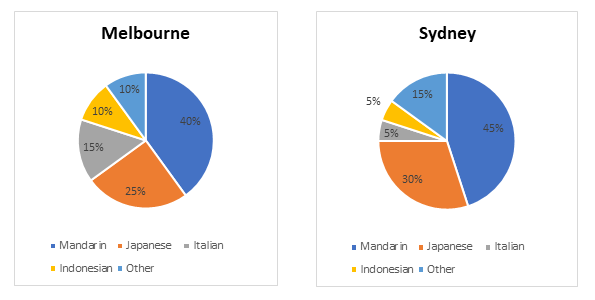
The charts below show the percentage of second language classes taken by Australian secondary school students in Adelaide.
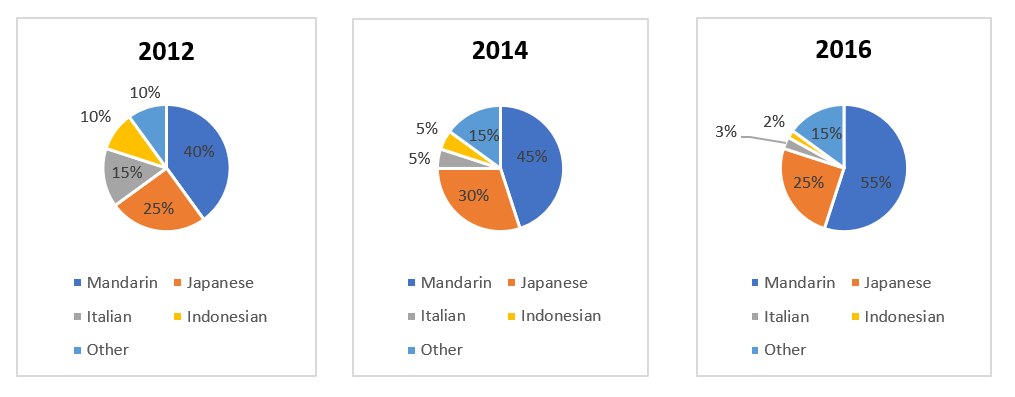
Sometimes data can be displayed in table form, where it can be categorised in both linear or non-linear ways, similar to bar graphs and pie charts. The data can be displayed in numerical or percentage form.
The table below shows the number of registered junior players in 4 different types of football in an Australian city in 2015 according to 3 different age groups.
Here you can see that the data can also be categorised by age group, which is another way to display data besides just according to place or time.
Combination
Besides these individual forms of displaying data, you may find there could be a combination of graph types together, such as a line graph and a pie chart.
The diagrams below show the average cost of 3 different types of media device over a period of 6 years, plus their payment method for these devices according to 4 age groups in 2020.
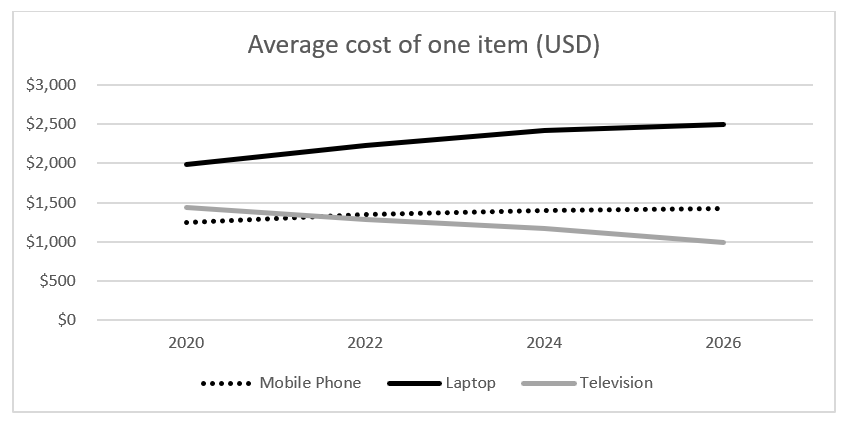
As you can see in this particular question, the time reference can also include future projections (the line graph continues until 2026).
Sometimes you may be asked to describe a process. These can be either of something that is man-made or something that occurs in nature. Take note that a process task has a starting point and ending point (make sure you mention all steps in the process). Process questions also need to include an overview.

In tasks that ask you to compare and contrast maps, they can either be of an indoor space (e.g. a floor plan) or an outdoor space (e.g. buildings, roads, nature, etc.). It is normal to have a task that shows maps with two different dates:
Two dates in the past (e.g. 1966 & 2016)
A map in the past and a current map (e.g. 2016 and present)
A map in the past or present compared to something that is projected or planned in the future (e.g., present and 2032)
The diagrams below show the features of the town centre of Trentville in 1966 and compares them to the changes that could be seen in 2016.
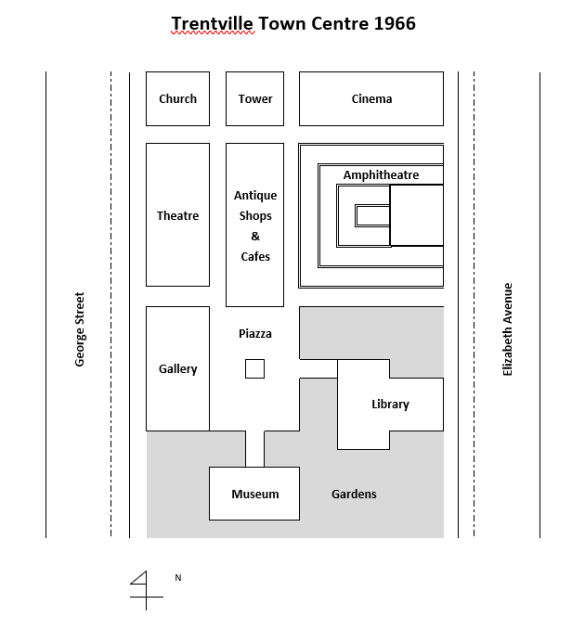
Share this article
You may also like.
Grammar 101: Understanding verb tenses
How to book IELTS One Skill Retake?
Grammar 101: How to use who and whom correctly?
Your vs You're: Learn the difference
Your pocket guide to IELTS Academic Writing: Know it before you ace it
Words and phrases commonly misused
There vs Their vs They’re – Learn the difference
The difference between IELTS Academic and IELTS General Training
Question types in the IELTS General Training Writing test
Question types in the IELTS Academic Writing test
- Useful links
- Who accepts IELTS?
- News and articles
- IELTS Masterclass
- Your IELTS results
- IELTS General Training
- IELTS Academic
- IELTS Online
- IELTS by IDP app
- Find sessions
- Check IELTS results
- Middle East
- Netherlands
- New Caledonia
- New Zealand
- Papua New Guinea
- Philippines
- Saudi Arabia
- Solomon Islands
- South Korea
- Switzerland
- Legal notices
- Privacy policy
- Cookie policy
- Copyright 2024 IDP IELTS
- Skip to primary navigation
- Skip to main content
- Skip to primary sidebar
- Skip to footer

IELTS Advantage
IELTS Preparation Courses
IELTS Writing Task 1: Everything You Need to Know
Ielts writing task 1 in 6 simple steps.
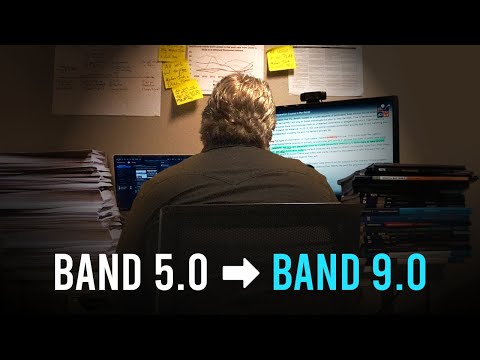
Academic Writing Task 1 Strategy
- Understand how the test is marked. Knowing the marking criteria will allow you to give the examiner exactly what they need.
- Paraphrase the question. It is best to paraphrase the question in the first paragraph. You can do this by using synonyms.
- Write the overview. To write your overview , pick 3 or 4 of the main features and write about them generally without referencing any data.
- Support the main features. In a new paragraph, support the key features with the data in the information given to you.
- Check your work. Check your report for spelling and grammar mistakes. Make sure that the data you mentioned is also accurate!

Essential Writing Task 1 Skills
- How to Write an Overview Paragraph
- How to Paraphrase
- How to Write a Complex Sentence
- How Many Words?
- Task 1 Charts Checklist
- Task 1 Tips
- The Danger of Synonyms
- 6 Common Mistakes
- Paragraphing and Editing
Writing Task 1 Full Lessons
- Writing Academic Task 1 in 5 Easy Steps
- Charts Lesson
- Maps Lesson
- Multiple Charts/Graphs
- Process Lesson

Academic Task 1 Sample Answers
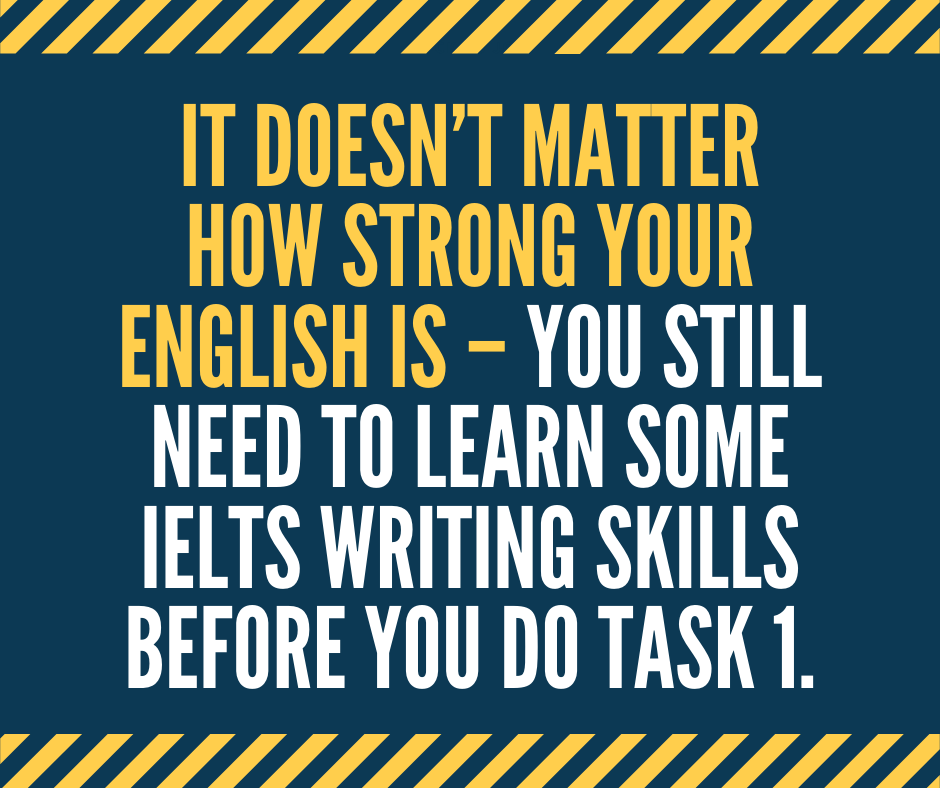
- Bar Chart Sample Essay (Cars in Asia)
- Process- Cement and Concrete Production
- Pie Chart (Italy and Yemen Populations)
- Process Question
- Bar Chart Question (UK Telephone Usage)
- Line Graph (US Consumption of Energy)
- Bar Chart Sample Answer (International Students)
General Training Writing Task 1

General Training Writing Task 1 in 5 Simple Steps
- Understand how the test is marked. Knowing the marking criteria is the best way of giving the examiner exactly what they need and nothing else.
- Decide whether the letter is formal or informal. This part is easy. If the question asks you to write to a ‘friend’, it should be an informal letter. If the question asks you to write to anyone else, it should be a formal letter. It is that simple!
- Discuss each bullet point from the question. Make sure to take a new paragraph for each bullet point. This will make your letter easy to read and understand.
- Sign off your letter. Don’t overcomplicate this part. Include a sign-off suitable to your letter’s tone and write your name beneath.
- Check your work. Make sure your letter doesn’t contain any grammar or vocabulary mistakes.
- Letter Writing Tips
- How to Write an Informal Letter
- How to Write a Formal Letter
General Training Essential Writing Task 1 Skills
- Task 1 General Training Writing Strategy
- Task 1 General Training Writing Guide
Sample Answers
- Formal and informal sample letters.
Writing Task 1 Essential Information
- People doing the Academic test will write a report on a data set, map, or process. People doing General Training will write a letter.
- You must write 150 words or more.
- You should spend around 20 minutes on this part of the test.
- Task 1 is worth 1/3 of your total mark on the Writing test.
- You will be assessed in four areas: Task Achievement (25%) Coherence and Cohesion (25%) Lexical Resource (25%) Grammatical Range and Accuracy (25%)
- The most important thing is that you can demonstrate that you can clearly communicate in English.
- The key to doing well is to know exactly what the examiners want and give it to them.
- Grammar and Vocabulary Guide

- Top 10 Grammar Mistakes
IELTS Writing Task 1 FAQs
How can i improve my writing.
You will find all the resources you need on our Writing Task 1 page. Click the link below:
Writing Task 1
If you need serious help or personalised feedback, you should check out our online course. There is a waiting list, but you can add your name here:
How can I get a Band 7, 8 or 9?
The answer to this question is different for every individual IELTS student, as it depends on a number of factors, including your work ethic, English skills and exam strategy. You'll find a guide to answering this question in this article
If you need serious help with improving your IELTS scores, you should check out our online writing course. There is a waiting list, but you can add your name by clicking the link below:
Can you correct my writing?
Please click the link below and it will give you all the information you need about our writing correction service:
Writing Correction Service
Do you have any sample answers?
Yes, you will find them at the link below:
Task 1 Sample Answers
Will using 'high level' or 'academic' words help me improve my score?
Probably not.
Read my recent article about IELTS vocabulary here:
5 Things You Need to Know about IELTS Vocabulary
How many paragraphs should I write?
Introduction
You can put the overview at the end if you'd like.
Can I use idioms?
No, you should typically avoid using idioms in Writing Task 1.
The only time this is acceptable is if you are taking the General Training test and must write an informal letter.
Should I write a conclusion for Task 1 Academic?
No. A conclusion is a summary of YOUR ideas and your opinion. Task 1 is simply reporting what you see, so there shouldn't be any of your ideas or your opinion.
Instead of a conclusion, you should write an overview.
The reason lots of people get confused about this is that some teachers, books and even one British Council website call the overview a 'conclusion'. It's not a conclusion, it's an overview.
Finally, it does not matter where you put the overview paragraph. We teach our students to put it after the introduction, but it is also fine to have it as your final paragraph.
How many words should I write?
You must write at least 150 words in Writing Task 1 (yes, the examiners will count them!)
I would suggest that you aim to write around 160-170 words for Task 1. Aiming for 20-30 words more than the required amount makes you more likely to reach the word limit without setting an unrealistic goal.
Will I lose marks if I don't write enough words?
Yes. If you don't write the required number of words, you will lose marks in 'Task Achievement' for not answering the question fully. Read more here .
Can I use contractions?
No, should not use contractions when you are writing an academic essay or formal letter. However, it is fine to use contractions in an informal letter.
When should I write formally?
There are a few signposts that indicate when you should write formally or informally. Watch our video lesson to find out what they are:
IELTS Writing Task 1 General Training: Formal or Informal Letters?

A Complete Guide on IELTS Academic Writing Task 1
In Academic Writing Task 1, you will be given one or multiple diagrams that can be in many forms such as, graphs, pictures, data tables etc. You will be asked to write an essay on the given diagrams.
You will need to write at least 150 words for this essay. Yes, you can write a few more than 150, but never go below 150. If you write even 149 words, you will lose marks. To be in the safe zone, write 170-180 words. However, we recommend not exceed 190. If you write 195/200/200+, it will be too many words and will damage your score.
In fact, you are required to show how well you can communicate in English. Understanding the question properly and then answering precisely is one of the important communication skills. If you write less than the instructed number of words, or if you write too many words, the examiner will get the impression that you have failed to understand the basic instruction sentence.
3 Simple Steps for Academic IELTS Writing Task 1
You need to do three simple things for Academic IELTS Writing Task 1. This is all you have to do for this task:
Paraphrase the question sentence
Write an overview paragraph
Focus on one or two key features
If you can cover just these 3 bullet points within 160-180 words, you are absolutely fine.
Task 1 Question Types
There are 7 types of questions for Academic IELTS Writing Task 1. Click on each question type to read their step by step detailed discussions.
A pie chart is a circular statistical graph which is divided into slices that illustrate proportional relationship.
A line graph is a line that is connected with individual data points showing quantitative variations over the time.
A bar chart presents categorical data with rectangular bars with heights or lengths proportional to the values that they represent.
Table Chart
You might be given one or two data tables. You will need to describe the significant data changes for the given time.
Process Diagram
You will be given a picture or a drawing that shows the production steps of a final product, or the working procedure of a mechanical device/machine etc. Most of the students fear this question not because it is difficult, but because of their confusion how to answer this.
This is a very easy question to answer. There will be no data to analyse in this question type. It will be all about comparing between 2 or 3 maps.
Multiple Graphs
There will be more than one data diagrams. You will need to describe major changes or relations among them.
Writing Task 1 Essay Structure
Paraphrasing the question sentence
Overview paragraph
The first body paragraph
The second body paragraph
It's actually very easy to get a good score in IELTS writing task 1. Just write the major features that are very obvious in the graphs. Don't write anything that is minor or not in the graph. Click Academic IELTS Task 1 essay structure and jump to the detailed discussion.
Check the following resources:
A complete guide on IELTS Writing
A complete guide on General Training Writing Task 1
A complete guide on Writing Task 2 (GT + Academic)
IELTS Preparation with Liz: Free IELTS Tips and Lessons, 2024
- Test Information FAQ
- Band Scores
- IELTS Candidate Success Tips
- Computer IELTS: Pros & Cons
- How to Prepare
- Useful Links & Resources
- Recommended Books
- Writing Task 1
- Writing Task 2
- Speaking Part 1 Topics
- Speaking Part 2 Topics
- Speaking Part 3 Topics
- 100 Essay Questions
- On The Day Tips
- Top Results
- Advanced IELTS
IELTS Writing Task 1: Essential Preparation Tips
Below are the essential preparation tips to learn how to prepare for your IELTS writing task 1 test. These top 12 tips are for the IELTS academic writing paper.
1. Understanding Task 1
- write an academic report on a chart of graph (see below for all types of task 1)
- write over 150 words (the examiner will count your words and there will be a penalty for being under the word count)
- write your report in 20 mins (don’t take more time because task 2 is worth double the marks)
2. Practice Tests
Get the Cambridge IELTS Practice test book s. There are 9 books which have been published by IELTS. Each books contains 4 full IELTS tests which are authentic (real) past exam papers.
3. Task 1 Band Scores and Marking Criteria
Understand the band scores for each criterion in writing task 1. The IELTS examiner will mark you on:
- Task Achievement (25%)
- Coherence and Cohesion (25%)
- Vocabulary (25%)
- Grammatical Range and Accuracy (25%)
Get to know the requirements for each criterion for the band score you are aiming for. Here’s a link to the IELTS writing task 1 public band score descriptors which are published by IELTS. The examiner will give you a band score for each individual criterion above and then your final score for writing task 1 is the average of the 4.
4. Types of Task 1
Learn the 6 main types of charts that can be given in writing task 1 (maps, diagrams, bar charts, tables, line graphs and pie charts). You should practice writing reports for all types of task 1 by using sample IELTS charts . It is also possible to get a combination of two types, for example a bar chart with a pie chart.
5. Introduction Paragraph
Practice writing the introduction statement. Here are two examples, which one do you think it best?
- Here we can see that the graph represented information regarding the number of sales of two companies in two years
- The chart illustrates the number of sales of two companies (Marks Ltd and Bumper Store) in 2000 and 2010.
The introduction is usually very quick to write and quite formulaic (standard) in content. Here’s a link to see how to write an introduction for a bar chart .
6. Overviews for Writing Task 1
Practice identifying key features for all kinds of charts. The key features make up the content of the overview which is the most essential paragraph in your task 1 report. The key features for most charts are the highest and lowest categories as well as the most significant differences between categories. However, for diagrams the key stages can be harder to identify so here a link to a sample introduction and overview for an IELTS diagram. Many students get confused whether to have a conclusion or an overview – make sure you get it right.
7. Vocabulary
Get a list of useful vocabulary for each type of writing task. This is particularly important for line graphs, maps and pie charts. The line graph is the type of writing task 1 which has the biggest range of possible vocabulary that can be used. Here’s a link to vocabulary for line graphs .
To get a good score in writing task 1, it is important to use a range of words which means you need to paraphrase when possible. However, as mistakes can cause you to lose points, it is important not to take chances with your vocabulary. Spelling is also checked so make sure you don’t make mistakes with your spelling.
To get a good score, you will also need to work on complex sentence structures. For students aiming for band score 6 and above, this is essential. Luckily sentence structures for task 1 can be learnt and then adapted to fit each individual task (to some extent). Here’s a link to the 4 main sentence structures for a line graph . Along with grammar is accuracy. The more mistakes you make the lower your score will be so getting rid of common errors is important. Here is a link to spotting grammar mistakes for a pie chart. If you have frequent errors, you may get band score 5 for grammar.
9. Structure for Writing Task 1
You need to make sure you structure your report correctly as the examiner will pay attention to the organisation of information and paragraphing. Here’s a link to the structure for IELTS writing task 1 report. Make sure you follow this as it is easy to get a good score for organisation. Structure and linking devices are part of the criterion of Coherence and Cohesion which makes up 25% of your marks.
10. Linking Devices
Linking is also very important. You will need to show the examiner a range of linking devices that connect information together and compare information in a coherent way. Again, linking is very easy to learn so make sure you pay attention to this. Different charts use different linkers so make sure you review each type of task to see the best linking devices to use.
11. Model Answers for IELTS Writing Task 1
Follow safe models. There are a lot of sample answers for you to follow on the internet, but following a safe model which fulfills the requirement set by IELTS is essential. Here’s a link to a complete lesson on how to write a pie chart report paragraph by paragraph.
12. Practice using the Answer Sheet
Before your test, make sure you practice writing on the official IELTS answer sheet for writing task 1. Watch this video lesson to learn why you should practice with the answer sheet and how to fill it in properly. Here is a link to download the answer sheet .
Recommended
- How to describe a bar chart : Video Tutorial
- Line Graph Model Answer Band 9
Hi Liz, The information provided in your blog was very useful for my success at the exam. Your valuable time committed to provide us information is highly appreciated. I salute for your service. Thanks lot. from Sri Lanka
Glad to hear you did well 🙂
You are really a nice teacher and i did my best through your videos. Free of cost ahahahahahhahah
Hello there Liz how’s your condition ? hope you are doing well, Since You have mentioned that there are 9 IELTS Cambridge practice books, but the last I checked, there are 17 volumes, which ones do you suggest to start for band score 8 for Ielts general training, as an upper intermediate English speaker? I appreciate your support and tysm for this amazing website
Each year IELTS publish a new book. Book 17 is the latest. However, previous books are still fully valid as the test hasn’t changed except in very minor ways, such as being on computer or the listening test no longer having an example at the start of the audio.
Hi Lizzy . Please I can’t t see your recent videos.
I stopped making videos in 2015 and will start again once my health improves. I do, however, continue updating this website with new tips and lessons.
Hey Liz, Today is my first day of IELTS preparation and I found this amazing creation by you. Its already making things easier. Thank you so much!!
I’m glad my lessons are helping you 🙂
Hi Liz. Thank you for the free lessons and tips. I will like to know if the overview for task 1 Writing can be separated from the intro soon a separate paragraph.
Yes, definitely. I usually write my overview as a separate paragraph as it’s the most important paragraph in task 1.
Hi, Elizabeth. It’s been a pleasure for me to practice woth your resources. Thanks for building such a prolific platform for IELTS aspirants
You’re welcome 🙂
Thanks a lot for you great explanations! Just wanted to let you know the link to “conclusion or overview” under point 6 is broken. Best,
Thanks David. I just fixed it. Happy 2021 !
Thank you so much Ma. Your site was very useful to my preparation. My results just came in and I scored 8.0. I’ll gladly recommend this site for others. God bless you!!
Wonderful news!! Very well done 🙂
I cannot thank you enough for the tip to write an overview after the introduction paragraph. I have just received my test results for IELTS Academic and they are 8.5 overall and 7.5 for Writing. I had limited time to prepare for the test and read the tip while in a cab on the way to the test venue. During the Writing part I did the Task 2 first and it took me all of the 41 minutes (and 440 words), with only 19 minutes remaining for the Task 1. Luckily, it was a simple chart and I wrote the introduction and overview first, then wrote two body paragraphs with barely a minute to check for typos and the time was up. I ended up writing 220 words and would have written more if not for the time limit. However, since I made sure I wrote the overview first, I was able to relax and found it so much easier to concentrate on the details of the chart. Thank you for the brilliant idea! None of the other teachers online came up with it.
Great results 🙂 Writing the overview after the introduction is logical. Task 1 is a report and the overview contains the main details of the report so having presenting that early helps both the reader and the writer. Also, as you said, it ensures you don’t miss it if time is limited. Well done to you 🙂
I am glad to have come across this material for the preparation of IELTS exam, Just wanted to know about the general mistakes I (a candidate) might have been doing while going for the Writing portion of the Test. Just to give you a brief, I have appeared for IELTS about 3 times now and have never touched band 7.0 in each attempt (To be precise, I got 6.5 in all attempts in writing particularly), However rest of the sections speak a different story (Getting at least 8.0 in each section respectively). Can you please advise as to what I might be doing wrong in Writing section in particular. I try to increase my Vocabulary learning new words each day and implement those words in my sentence formations as well.
Be careful learning new words and using them in your essay. If you use them incorrectly or inappropriately, your score will go down. It takes time to learn words properly so that you can use them without errors. Avoiding errors MUST be your main goal in IELTS Writing. Also review ALL my free lessons and tips: https://ieltsliz.com/ielts-writing-task-2/ . Then consider my Advanced Lessons which will give you the right techniques for a high score: https://elizabethferguson.podia.com/
Hi Liz, Your site is very helpful! Thank you! I see you have recommended the Cambridge IELTs book. They have now released no. 10. Would this be a good resource for the Academic test? I am a native English speaker but not achieving the writing score I need. Your help would be greatly appreciated! Kind regards, Jade
Book 14 is the most recent and book 15 is coming out this summer. They are the only authentic past papers you can buy. Yes, you should be using them. How many you wish to get is your choice and will depend on how much prep you wish to do. These books contain tests, not training or advice or understanding. They won’t help you learn how to tackle IELTS writing and they won’t help you understand the band score requirements. Try my free lessons: https://ieltsliz.com/ielts-writing-task-2/ and my Advanced Lessons: https://elizabethferguson.podia.com/
Sorry The question about private lessons and marking writings was meant to be asked to you, Liz. I need the answer as soon as possible please.
Unfortunately, because I work alone, I do not have time to offer private lessons or marking. However, my advanced writing task 2 lessons are very detailed and will answer most of your concerns: https://elizabethferguson.podia.com/
Someone who corrects my essay tells me that don’t use brackets if you want to have high scores. So, i’m quite confused about it because you said it is perfectly normal to use brackets in writing task 1 in the video.
It is completely fine to use brackets for task 1. However, don’t overuse them. Always show flexibility and a good range of sentence structures by presenting data in different ways.
Thanks a lot Liz. This website is really helpful to prepare IELTS.
i am unable to download the answer sheet of IELTS writing test. The link already present is broken. Can you please attach the correct link here.
Thanks for letting me know. I’ve just put up a new link.
No words enough to show my gratitude! May God bless you.
Thanks Liz.
I absolutely loved your site and way of guiding to obtain a good IELTS result.
My writting task definitely felt much better with your tips and guidance.
Today I took the test, I hope the results are positive.
Keep up the good work!
Fingers crossed for you 🙂
What is your result?
Morning Liz, Really appreciate all your efforts! Is there any Videos for “Writing- Letter (General Testing). I see lot of sample letter questions. But there are no sample letters to actually read through the whole letter and grasp the idea or I may be overlooking 🙂 Please advise- Harry
There is a link above to model letters which are full letters that you can read and learn from for IELTS.
Could you please let me know if for task1 in Ielts Academic we may receive to write a letter or that is the case only for Ielts General ?
See this page: https://ieltsliz.com/ielts-writing-task-1-lessons-and-tips/
Thanks for all your great efforts! I am wondering if it is fine to have only two sentences in my body paragraphs. Though it can be seen in examples you have provided, some other teachers say it should be at least three sentences. Which one is correct?
There is no such rule in IELTS. For writing task 2, all main points should be fully extended which means that the body paragraphs are mostly of equal length. However, writing task 1 is not an essay, it is a report. Paragraphs are not balanced in length. It is even possible to have a paragraph of one sentence. It’s fine for teachers to advise you, but they should point out that it is advice and not a rule.
Hi, I`m a content maker in iran and we work on teaching EFL. Your content is so helpful and comprehensive. i appreciate that and wish you best
Hi.. Thank you for the information. I would like to ask you a question in writing test. Is it ok if we write the reason why is the percentage different from one year to another year? Thank you
If the reason is stated in the chart, you can write it. You can only provide information that is visible in the chart – you can’t add opinions.
Thank you very much for your everything on IELTS. I Learned a lot.
I realized that now exam patterned changed little bit as Writing Task 01 , they normally give two different charts (Bar Chart & Table or Line graph with Pie Chart) .
Hope you will add some models for these kind of things.
Rgds Lalith
The patterns have not changed. They gave multiple tasks and single tasks in the past, and they do the same now. You can find model answers for all kinds on this page: https://ieltsliz.com/ielts-writing-task-1-lessons-and-tips/
i love you mam thank you soo much
Hy Liz, I just want to tell you that you are doing an amazing job, by helping alot of people understand the mechanics of IELTS, and that too for free.You are an amazing human being, may the blessings of Allah be upon you.
I followed you and IELTS Cambridge books religiously from the day i started preparation, yesterday i got my result and i got an overall 8.0 with 9.0 in reading, 8.5 in listening, 7.0 in speaking and 7.o in writing in contrast to my previous result of 7.o overall.
Thanks a lot liz and keep doing the wonderful job you are doing.
Brilliant !! Such a great improvement from band 7 to 8 !! Very well done to you 🙂 Thanks for letting me know 🙂
Hello Liz, I have some challenges in my writings. I am weary of task 2 essay writing. Pls advice me. Thanks
Get my advanced lessons – you will quickly learn how to tackle them properly: https://elizabethferguson.podia.com/
Hi liz, Can overview contain numbers, percentages or years? I have my exam very soon. Please respond at your earliest.
Yes, it is possible. There is no fixed rule. The majority of the time, the overview will contain only description. But there are cases (such as totals in a table) when the overview might contain numbers.
What if i write task 1 on task 2 sheet and task 2 on task 1 sheet.
If you do that, you will need to change the heading on the paper so that the examiner knows clearly and easily which paper is which.
Hi liz, i noticed you skipped task 1 for general training. Please how does one fill this void
On this page: https://ieltsliz.com/ielts-writing-task-1-lessons-and-tips/ , you will find essential tips for GT letter writing and also model letters.
I want to improve my speaking
See this page: https://ieltsliz.com/ielts-speaking-free-lessons-essential-tips/
Could you please upload video with tips for writing task 1 in GT . I am going to take GT in September 9.
I won’t be making more videos until next year.
Can we write hammering the last nail in task 2 of ielts wrtting in place of to conclude🤔
Don’t use informal language in an IELTS essay.
Hi liz can i ask what is the difference between campbridge textbook ielts 9 and 10? What book should i used?? Im a nurse im planning to get ielts next year.
Each book contains 4 real IELTS test published by IELTS. The books are published in order of age: book 12 is the most recent. You can use all books to help you prepare, but books 9 – 12 are the best.
From where I get written samples for writing task so I can check the pattern and follow it in my practice?
See the main pages of this website. Here is the main page for writing task 1: https://ieltsliz.com/ielts-writing-task-1-lessons-and-tips/
Hello Liz, I really appreciate your effort for posting such a useful videos. can you upload some videos of general writting task 1.
I won’t be making more videos until later this year (if I’m lucky). But I will put GT videos on my list 🙂
Hi Liz, Your website is very essential for IELTS preparation. Can you please upload a video about writing letters for general training writing test 1. Thanks and best regards.
I hope to make more videos at the end of this year.
Thank you miss. Elizabeth Oh! I could find a mistake for you, I am enthusiastic to go to the exam now 😀 * second introduction statement is better
Hi Liz, First of all I’d like to thank you for your efforts and hard working to help us improve. I have a question about academic writing task 1. what are the maximum words that we should write? Is it ok if I write 216 words in this task? Best regards, 😀
If your writing task 1 report contains too many small details, you will get a lower mark. 25% of your marks for task 1 is your ability to select information and highlight key features. Of course, if the chart gives few details, then you might present all but if there is plenty of information to present then you must be selective. So, writing over 200 words is not showing the skill of selecting.
Do you have an overview of when to write a conclusion section for writing part 1? Thank you in advance!
Kind regards
See this page: https://ieltsliz.com/ielts-tips-conclusion-or-overview-for-writing-task-1/
i wann practise ielts writing part .
https://ieltsliz.com/ielts-writing-task-2/
Hi Liz, I am planning to retake IELTS exam because I was unable to get a score of 8 and above for my writing. I need someone to critique my essays. Can you help me on this? Please contact me at: [email protected]
See this page: https://ieltsliz.com/ielts-essay-correction/
Mam… First of all Thanku so much for this website this helping us a lot for preparation… I wanna knw that what is the difference between the Cambridge ilets 9 and 11 which book is to be purchased
Book 11 is the most recent. So, go for that one.
my writing band score is not increasing.why
Go to the main writing pages, and then read about the band scores. Find your weaknesses. Alternatively see my advanced lessons: http://subscriptions.viddler.com/IELTSLizStore
hii Liz…I really appreciate your efforts for creating such a wonderful platform to score in IELTS.Your videos are helping me a lot.Thank you so much..:)
I have a question on writing task 1 . Is it fine if I write upto 190 words?
I look forward to hearing you soon.. Thanks.. Best, Pramit
There is no upper limit. Just make sure you are being selective with the information and not including irrelevant information.
Thank you so much for the response. Best, Pramit
Hi Liz, Thank you very much for helping us. I have a query about word counting. Number of articles are considered in 150 words? I look forward to hearing from you Liz. Best Regards, Manobendro Sarker
All words – big and small are counted.
do we have time for rewriting?
You have a total of 1 hour for two tasks. Time is very limited.
HI MRS Liz i have one question , when we use amount and number n how ? pls clear it for me as soon as u can because my exam next three days
should we write a conclusion or not
You will find a whole page about conclusions and overviews on this page: https://ieltsliz.com/ielts-writing-task-1-lessons-and-tips/
hi liz, can we write figures in overview paragraph?
If they are totals, yes.
from where to i could start ilets practice….?
See the video on my home page: https://ieltsliz.com/
jass…. is there any difference in idp and bc marking test
No. The marking criteria are exactly the same and the examiners are trained in the same way. These are not separate companies when it comes to IELTS, they are both co-owners of IELTS.
Hi liz!! Can I use present contin. in WT 1? , Thank you for your data!
https://ieltsliz.com/liz-notice-2015-2016/
mother u explained well
hi mam. when u will be back ?
Hi, In writing task-1, do we also have to analyse the figures? Like for example, if the question is about people listening radio and watching TV, then do we also have to write like..people probably don’t watch TV in morning because they are working in office. Or we just have to stick to explaining the graph backing the statement by data? (Interpretation and analysis both or just the interpretation?)
You never give an opinion or try to give reasons for it. You report what you see. This is report, not an essay. All the best Liz
Do you have an idea in terms of which test is easier to take on the following: IELTS Academic,PTE Academic,TOEFL and CAE?
Sorry, I only work with IELTS and am not very familiar with other testing systems. Liz
Thanks for responding,in terms of the academic,how different is it from the GT? I know listening and speaking its the same exam. The difference is on reading and writing where in writing there is the issue of graphs being part of the curriculum.
I have a date on the 19th of November and i want to ask for assistance in terms of advice as to which areas i can make sure by the time i get to the exam will have mastered. regards Jasiel
The GT test is slightly easier for writing and reading. See these pages: https://ieltsliz.com/ielts-gt-academic-writing-differences/ and also https://ieltsliz.com/ielts-general-training-reading-information/ All the best Liz
Kindly assist me,I took a GT exam for immigration to Australia and did not do well in listening because i want 8 band across all modules.
I have a date for academic but wanted to find out if the band will be reduced because i am taking Academic instead of GT, and is it difficult as people say because i could have taken CAE,TOEFL,PTE Academic but feel with the knowledge i accumulated on this site better to do IETLS
regards Jasiel
Sorry, I don’t have information about immigration. Make sure your English is strong enough to get band score 8. If your English is not good enough, you must work to improve it before you book your next test. All the best Liz
Hi, there! Liz, your website is awesome! I’m lovin’ it! The thing is, as I was reading through the pieces of advice you’ve shared above, I came up to something that made me really confused. And that is “Why are you saying ‘each criteria’ instead of saying ‘each criterion’? “
The reason is that I’m not careful when I type quickly and don’t proof read enough. Thanks for spotting it! All the best Liz
Dear liz, Just have one doubt about cocluding task 1. What is the appropriate way to do.
There is no conclusion for writing task 1. Liz
and overview is must in every task 1?
Only in academic writing task 1.
Hello Liz I have question .. The following is writing task 1 statement “The bar chart below shows the percentage of people in UK living alone by sex and age in 2004/05 “.. Is it possible to paraphrase it to the following “The bar chart illustrate the amount of people in UK who are living alone in terms of percentage dividing according to their age and gender during the period 2004/05.. Is that a good paraphrase? If it is not, who can I make it better?
Sorry, I do not give feedback on writing. Liz
Hello Liz I have question related to the overview paragraph, Is there any words except overall by which we can start our overview paragraph ???
“Overall” is the most appropriate to use. It helps the examiner locate your overview quickly and easily which helps you get a better score. Liz
Hi Liz, In writing task 1 (Academic) there are two pages provided. My question is if I want to write more should I continue on subsequent pages given for task 2 or should I ask for separate sheets meant for task 1.
Please reply soon as I my exam is approaching very near.
Thanking you in advance, Rushi
At no time you should write more on any page for task 1. You should never write over 200 words and that will easily fit onto the page given to you. All the best Liz
Can I ask for an additional piece of paper to use it as a draft for planning my WT2 essay?
No. All plans are made on the question paper. If you need extra paper later in the test because your answer sheet is full then you can ask – but not for planning.
Good day Liz! Is it possible to get a bandscore of 7 even if one was’t able to finish task 1? Is it true that examiners are turned off to see so many less common words in essays?
Any writing which is under the word count will get a lower band score. These are the rules set by IELTS. All the best Liz
A big Thank You! 🙂 for all your efforts, a very good blog for ilets preparation with all information at one place. It help me improved a lot and i could score an overall band 7 (L:7, R:7, W:6, S:7) which i think, wouldn’t have been possible without all your tips and videos and samples.
Thank You!!! 🙂
Band 7 is a strong score. Well done! I’m glad my blog was useful 🙂 All the best Liz
Awesome website for Ielts prep Thanks Liz for your dedication and simplicity in L R W S Just 2days before I checked ur writing topics and videos Which boosted my score to 7band in writing thanks a ton
overall, I got 6.5 (L:7,R:6.5,w:7,S:6) lost 7band just by .5 band it could have been not possible without ur brainstormed ideas ur website provides
That’s a good result! Thanks for letting me know. Getting band 7 in writing is very good. All the best Liz
Great website, keep the good work going on.
Please give a link to clear instruction for how to prepare for TASK 1 & 2 GT writing,
There are model letters and tips on this page for GT writing task 1: https://ieltsliz.com/ielts-writing-task-1-lessons-and-tips/ . All lessons for writing task 2 are for GT and academic students – the essay techniques and questions types are exactly the same. All the best Liz
I have observed many candidates asking about getting exhausted by the time they have to do writing and I have also felt the same by the time we come to writing. Its just that we cannot brainstorm effectively and also we are trying hard to write something but we may turn away from the topic and realize it later
Can you please provide advice of how we can keep ourselves active by the time we reach writing. Thanks
I wish there were special tips but it’s a long test and all students will feel tired by the time they arrive at writing task 2. The only way to avoid making mistakes with your essay is to plan properly. Most students read the essay question and start writing which is why they make mistakes and go off topic when they are tired. But if you spend 5 minutes (at least) analysing the essay question and planning your ideas, how to present them and supporting points, you’ll be fine. Here’s a page to read about planning: https://ieltsliz.com/ielts-writing-task-2-essay-planning-tips/ Liz
Thanks Liz.That’s an amazing tip. I can remember myself in a similar situation, where I started writing and than later realized I have been writing away from the topic.
I will make sure that the essays I am going to practice further should include brainstorming and than following the plan to write essay. I believe in this way we will not go back and forth and can keep our focus towards given topic only.
Hi Liz…I have a question about conclusion in task -1.You said that conclusion should not be given but in official IELTS Cambridge model answers they have conclusion or overview in final passage of task -1.Please state your view on this.
There is an overview paragraph not a conclusion. The overview can be after the introduction or at the end of the report. Please watch my free video lessons to learn about the overview and the possible locations. Liz
Speak Your Mind Cancel reply
Notify me of new posts by email.
Advanced IELTS Lessons & E-books

Recent Lessons
Ielts liz personal update 2024, ielts model essay -two questions essay type, ielts bar chart of age groups 2024, ielts topic: urban planning, ielts listening transcripts: when and how to use them, 2024 ielts speaking part 1 topics.

Click Below to Learn:
- IELTS Test Information
Copyright Notice
Copyright © Elizabeth Ferguson, 2014 – 2024
All rights reserved.
Privacy Policy & Disclaimer
- Click here: Privacy Policy
- Click here: Disclaimer
Return to top of page
Copyright © 2024 · Prose on Genesis Framework · WordPress · Log in
IELTS Writing Task 1 – Sample Questions and Practice Resources

On the IELTS Academic exam, Writing Task 1 requires you to look at an informational graphic and describe the contents of the graphic in writing. In this post, we’ll look at different IELTS Writing Task 1 samples to prepare you for test day. In addition to advice and practice, you’ll also get our IELTS Writing Task 1 Examples PDF with Answers for portable prompts and model answers.
IELTS Academic Writing Task 1 Samples With Answers PDF
If you want a print-friendly version of the IELTS Writing Task 1 samples in this post, click below to access the IELTS Writing Task 1 examples PDF!
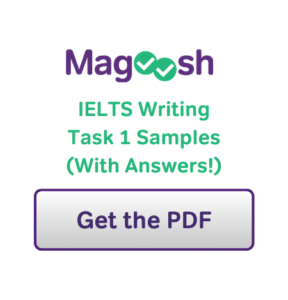
Note that all the IELTS Writing Task 1 samples are model essays for a band 9 IELTS score. The line graph sample prompt includes a detailed scoring explanation. You can learn more about scores for IELTS Writing Task 1 by consulting the official IELTS rubric .
- Take a good look at our guide to IELTS Writing Task 1 paragraph structure . The guide tells you everything you need to know about how Writing Task 1 essays and paragraphs should be structured, with an example question and model essay.
IELTS Writing Task 1 Samples: The Major Question Types
Below are questions for each common infographic in IELTS Writing Task 1: bar charts, pie charts, line graphs, process diagrams, and maps.
IELTS Academic Writing Task 1: Line Graph with Model Answer and Scoring Explanation
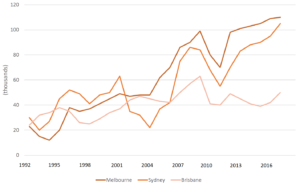
[/threecol_one_last]
IELTS Academic Writing Task 1: Bar Chart With Model Answer
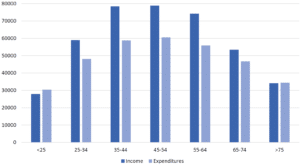
Pie Chart with Model Answer
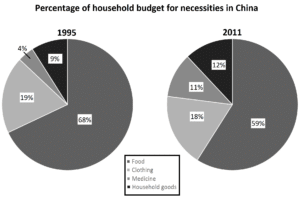
Process Diagram with Model Answer
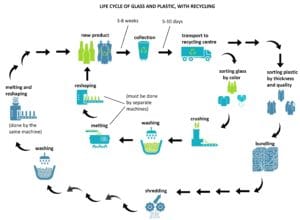

IELTS Academic Writing Task 1: Map with Model Answer
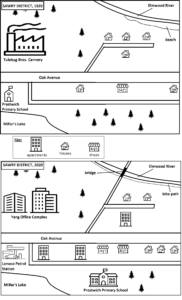
IELTS Academic Writing Task 1: Two Different Types of Graphics
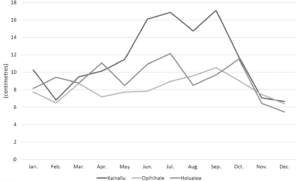
[/threecol_two][threecol_one_last]
Additional Resources for Writing Task 1
Now that you’ve seen some models for how this task is done, you should be ready for some real practice! Here are some resources from Magoosh that should help.
- Practicing using these common IELTS Writing Task 1 and Task 2 linking words .
- Familiarize yourself with the test with IELTS Academic Writing Task 1: Ultimate Guide video , and use a Writing diagnostic quiz to assess your current strengths and weaknesses.
- Use study schedules to help you find time to study and stay motivated. To help you organize your time, use this IELTS study schedule if you only have a week to go before you will take the IELTS. If you have a month, this one month IELTS study schedule offers more extended practice.
- Find high-quality study materials. We offer a huge collection of study reources for the whole IELTS Writing seciton ! Don’t forget about Magoosh IELTS Prep which includes lessons on IELTS Writing Task 1 (and all other sections of the exam!) to help you prep smarter. In addition to many video lessons and practice essays, the 6-month plan allows students to get feedback and scoring on four practice IELTS Writing essays; the 1-month plan includes feedback on one essay. You can also browse more recommended books and resources !

David is a Test Prep Expert for Magoosh TOEFL and IELTS. Additionally, he’s helped students with TOEIC, PET, FCE, BULATS, Eiken, SAT, ACT, GRE, and GMAT. David has a BS from the University of Wisconsin-Eau Claire and an MA from the University of Wisconsin-River Falls. His work at Magoosh has been cited in many scholarly articles , his Master’s Thesis is featured on the Reading with Pictures website, and he’s presented at the WITESOL (link to PDF) and NAFSA conferences. David has taught K-12 ESL in South Korea as well as undergraduate English and MBA-level business English at American universities. He has also trained English teachers in America, Italy, and Peru. Come join David and the Magoosh team on Youtube , Facebook , and Instagram , or connect with him via LinkedIn !
View all posts
More from Magoosh

Leave a Reply Cancel reply
Your email address will not be published. Required fields are marked *

All IELTS Academic Writing Task 1 Types (+Tips & Examples)
IELTS Academic Writing Task 1 can be a challenging test for many students. One of the reasons for this is the variety of question types that may appear on the test, including bar charts, line graphs, pie charts, tables, maps, diagrams, and more. However, understanding the different types of questions and how to approach them can make all the difference in achieving a high score.
In this blog post, we will explore all of the different types of IELTS Academic Writing Task 1 questions that may come up on the test. We will also provide examples and tips on how to approach each type of question, so you can feel confident and prepared on the test day.
Types of IELTS Academic Writing Task 1 Question
Here are all of the different IELTS Academic Writing Task 1 question types you need to know:
1. Describing a Line Graph
Line graphs are used to show trends or changes over time.

- What is the chart representing?
- What is the unit of measurement?
- Is there a specific time frame or interval shown?
- How many lines are displayed on the chart?
- What is the tense used in the description of the chart?
- Study the x-axis and y-axis labels and the units of measurement.
- Look for trends, fluctuations, and significant points on the graph.
- Introduction: Paraphrase the question.
- Identify the main trend(s) or pattern(s) in the graph.
- Highlight the main trends or patterns.
- Provide a broad description of the data, including any significant changes or fluctuations.
- Describe the trend and the significant changes.
- Break down the data by showing specific data points and trends.
- Compare and contrast the data if applicable.
- Use linking words and phrases to connect the data points and trends.
- Use a variety of verbs to describe trends, such as “rise,” “increase,” “grow,” “fall,” “decrease,” “drop,” and “level off.”
- Use adjectives to describe the degree of change, such as “dramatic,” “significant,” “moderate,” or “slight.”
- Use linking words and phrases to connect ideas and show relationships, such as “while,” “although,” “despite,” and “due to.”
- Use the simple present tense to describe general truths or ongoing trends, such as “the data shows,” “the graph indicates,” or “the trend is.”
- Use the past tense to describe specific data points or changes, such as “in 2015, the figure was,” “there was a sharp increase in,” or “the numbers fell dramatically.”
- Sample line graph and model answer:

It is important to identify the key features of the graph, such as:
- The highest and lowest points
- The overall trend
- Any significant changes
2. Describing a Bar Graph
Bar graphs are used to compare data between different items or groups.

- What is the main subject of the bar chart?
- What are the units of measurement used?
- Are the bars arranged in any particular order?
- How many categories or groups are being compared?
- What is the overall trend displayed in the chart?
- Identify the different categories on the x-axis and the values on the y-axis.
- Look for comparisons and contrasts between the bars.
- Identify the main differences or similarities between the categories.
- Compare the highest and lowest bars and any significant differences.
- Provide a brief description of the data, including any significant differences.
- Describe the comparison between the items or groups.
- Break down the data by showing specific data points and comparisons between the categories.
- Highlight the significant differences.
- Use linking words and phrases to connect the data points and comparisons.
- Use appropriate adjectives to describe the size or quantity of each category, such as “large,” “small,” “significant,” or “minor.”
- Use linking words and phrases to compare and contrast categories, such as “in contrast,” “on the other hand,” and “similarly.”
- Use the simple present tense to describe general truths or ongoing comparisons, such as “the chart shows,” “the data indicates,” or “the difference is.”
- Use the past tense to describe specific data points or comparisons, such as “in 2015, the figure for A was,” “B had a higher percentage than,” or “there was a significant contrast between.”
- Sample bar graph and model answer:

- The highest and lowest bars
- The most and least popular items
- Any significant differences
3. Describing a Pie Chart
Pie charts are used to show data percentages of a whole.

- What does the pie chart represent?
- What are the percentages or proportions shown?
- Are there any significant differences between the sections of the chart?
- What is the largest or smallest section of the chart?
- What conclusions can be drawn from the chart?
- Identify the different categories and their corresponding percentages.
- Look for the largest and smallest slices and any notable differences.
- Identify the largest and smallest slices and any significant differences.
- Compare the largest and smallest slices and any significant differences.
- Provide a brief description of the data.
- Describe the proportions of the groups
- Highlight the most and least represented groups
- Use percentages and fractions to describe each category.
- Use adjectives to describe the degree of difference between categories, such as “marked,” “slight,” or “significant.”
- Use linking words and phrases to show relationships between categories, such as “corresponding to,” “accounting for,” and “contributing to.”
- Use the simple present tense to describe general truths or ongoing proportions, such as “the pie chart illustrates,” “the data suggests,” or “the largest slice is.”
- Use the past tense to describe specific data points or proportions, such as “in 2015, the percentage for C was,” “D accounted for a smaller proportion than,” or “there was a slight shift in the distribution from.”
- Model answer:

It is important to identify the key features of the chart, such as:
- The largest and smallest segments
- The most and least represented groups
4. Describing a Table
Tables are used to present data measurements in a structured format.

- What is the main topic or subject of the table?
- What are the categories or variables being compared?
- How are the values arranged within the table?
- Are there any significant differences or patterns in the data?
- What are the highest or lowest values in the table?
- Study the headings and units of measurement for each column and row.
- Look for patterns, rankings, and comparisons.
- Identify the highest and lowest values and any significant differences.
- Break down the data by showing specific data points and comparisons between the rows and columns.
- Highlight the most and least profitable professions.
- Use appropriate adjectives to describe the size or quantity of each row or column, such as “lowest,” “highest,” “most,” or “least.”
- Use linking words and phrases to compare and contrast rows or columns, such as “in contrast,” “on the other hand,” and “similarly.”
- Use the simple present tense to describe general truths or ongoing rankings or comparisons, such as “the table presents,” “the data compares,” or “the figures show.”
- Use the past tense to describe specific data points or rankings, such as “in 2015, the number for X was,” “Y had the highest total of,” or “there was a significant difference between Z and.”

It is important to identify the key features of the table, such as:
- The highest and lowest values
- The most and least profitable professions
5. Describing a Map
Maps are used to show a location or a facility such as a street map and a plan of a building or site.

- What does the map show?
- What is the scale of the map?
- Are there any significant features or landmarks highlighted on the map?
- What is the overall trend or pattern shown in the map?
- What conclusions can be drawn from the map?
- Identify the key features of the map, such as roads, buildings, landmarks, and areas of open space.
- Look for patterns, such as the layout of streets or the distribution of buildings.
- Identify any changes or developments over time.
- Summarize the main stages and the overall process.
- The location of the shops or facilities.
- Highlight the distance between them.
- Describe the key features of the map in a logical and organized way.
- Use linking words and phrases to connect the different features.
- Use prepositions to describe the location of features, such as “to the north of,” “adjacent to,” or “surrounded by.”
- Use adjectives to describe the size, shape, or function of features, such as “large,” “narrow,” or “commercial.”
- Use the simple present tense to describe general truths or ongoing features or locations, such as “the map displays,” “the data identifies,” or “the area is.”
- Use the past tense to describe specific data points or locations, such as “in 2015, the building was,” “there used to be a park where,” or “the river flowed through.”

It is important to identify the key features of the map, such as:
- The location of different shops or facilities
- The distance between them
6. Describing a Process/Diagram
Process diagrams are used to show the stages or steps in a process and their order.

- What is the process being shown in the diagram?
- What are the main stages or steps in the process?
- Are there any key inputs or outputs shown in the diagram?
- Are there any significant changes or transformations in the process?
- What is the final outcome or result of the process?
- Identify the different stages or steps in the process and their order.
- Look for the inputs, outputs, and transformations that occur.
- Look for any significant changes or developments.
- Identify the main stages of the process and the inputs, outputs, and transformations that occur.
- Describe the main steps and the significant changes of the process in detail and the key features of each.
- Use linking words and phrases to connect the different stages.
- Use appropriate verbs to describe each stage of the process, such as “input,” “transform,” or “output.”
- Use linking words and phrases to show the sequence of stages, such as “after,” “before,” “subsequently,” and “finally.”
- Use the simple present tense to describe general truths or ongoing stages or transformations, such as “the diagram represents,” “the data outlines,” or “the process involves.”
- Use the past tense to describe specific data points or stages, such as “in the first step, the input was,” “there was a change in the output from,” or “the transformation led to.”

It is important to identify the key features of the diagram, such as:
- The starting and ending points
- The main steps
7. Describing Combination
A combination task may include two or more types of graphs or diagrams, and it requires candidates to compare and contrast the information presented.

- What types of charts or diagrams are included in the combination?
- What is the main topic or subject of the combination?
- How are the various elements of the combination related to each other?
- What is the overall trend or pattern shown in the combination?
- What conclusions can be drawn from the combination?
- Study the different elements of the visual representation and how they relate to each other.
- Look for patterns, trends, and comparisons between different types of data.
- Identify the different elements of the visual representation and how they relate to each other.
- Describe each element in detail and the key features of the different types of graphs or diagrams
- Compare and contrast the data presented.
- Use linking words and phrases to connect the different elements and show their relationships.
- Use appropriate language for each type of visual representation and show how they are related to each other.
- Use linking words and phrases to connect ideas and show relationships, such as “whereas,” “in comparison,” “in addition,” and “moreover.”
- Use appropriate tenses for each type of visual representation and make sure they are consistent throughout the analysis.
- Use linking words and phrases to connect ideas and show relationships between different tenses, such as “while,” “although,” “despite,” and “due to.”

In conclusion, the IELTS Academic Writing Task 1 test can be challenging, but understanding the different types of questions and how to approach them is crucial to achieving a high score. By familiarizing yourself with line graphs, bar charts, pie charts, tables, maps, and combinations thereof, you can feel confident and prepared on test day.
Remember to focus on the key trends, comparisons, components, data points, and features, and use specific data to support your analysis. With these tips and examples in mind, you can be well on your way to achieving your desired score.
Related Posts

25 Expert Tips For IELTS Academic Writing Task 2 Success

21 Complex Sentence Structures For IELTS Writing Task 1

100 Common Phrases For IELTS Academic Writing Task 2
Leave a comment cancel reply.
Your email address will not be published. Required fields are marked *
Save my name, email, and website in this browser for the next time I comment.
Plans & Pricing
- IELTS Scores
- Life Skills Test
- Find a Test Centre
- Alternatives to IELTS
- General Training
- Academic Word List
- Topic Vocabulary
- Collocation
- Phrasal Verbs
- Writing eBooks
- Reading eBook
- All eBooks & Courses
- Sample Graphs
IELTS Writing Task 1 Samples
Here you will find IELTS Writing Task 1 Samples for a variety of common tasks that appear in the writing exam.
The model answers all have tips and strategies for how you may approach the question and comments on the sample answer.
It's a great way to help you to prepare for the test.
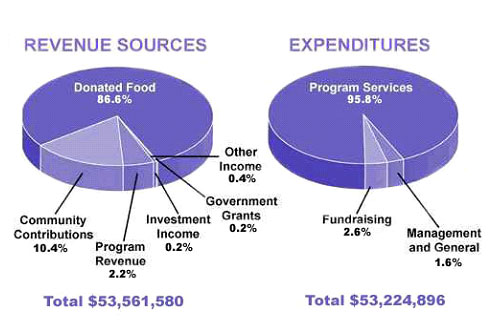
The amount of money that a children's charity located in the USA spent and received in one year, 2016.
Model Answer >>>
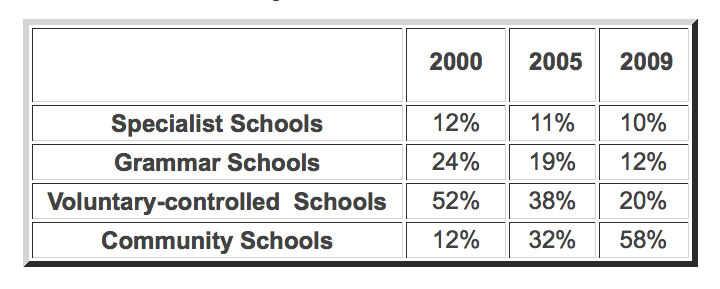
The Proportions of Pupils Attending Four Secondary School Types Between Between 2000 and 2009.
The city of Brandfield. City planners have decided to build a new shopping mall for the area, and two sites, S1 and S2 have been proposed.
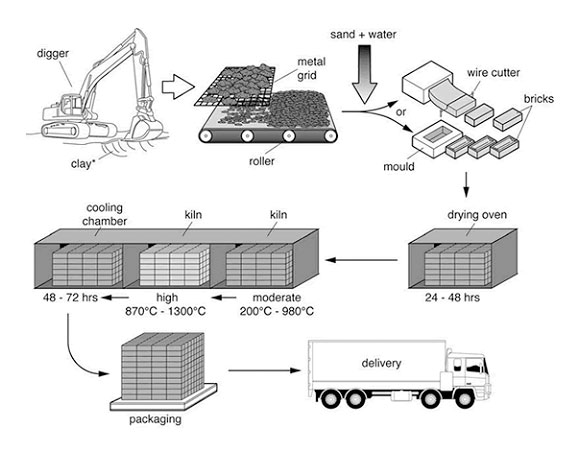
Process Diagram
The process that is used to manufacture bricks for the building industry.
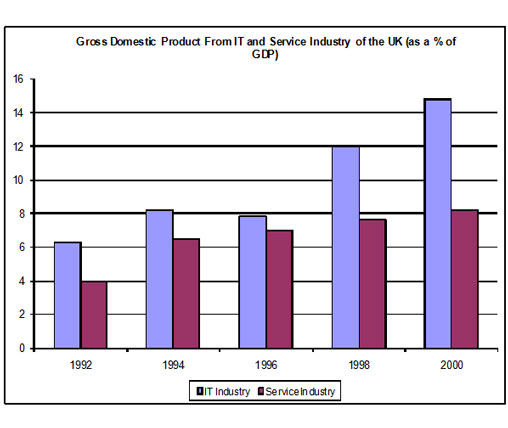
The components of GDP in the UK from 1992 to 2000.
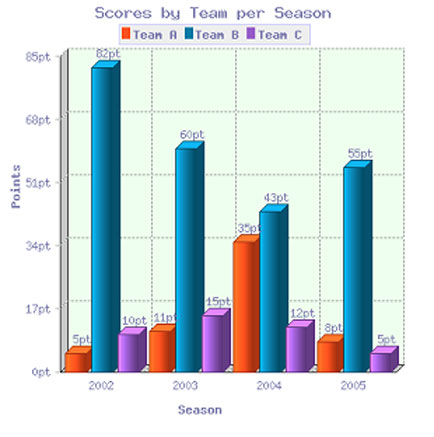
The scores of teams A, B and C over four different seasons.
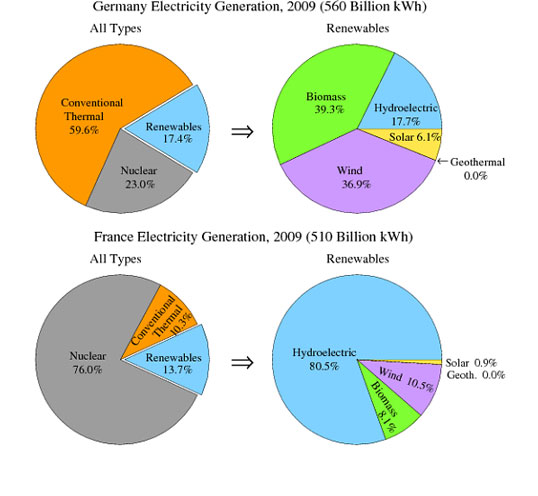
The electricity generated in Germany and France from all sources and renewables in the year 2009.
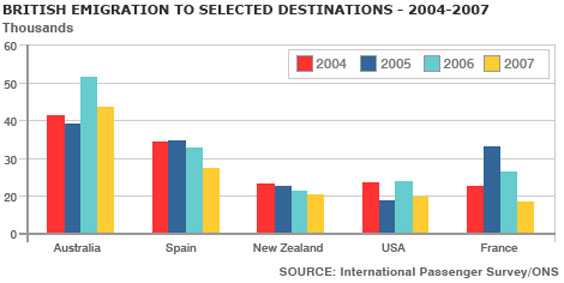
British Emigration to selected destinations between 2004 and 2007.
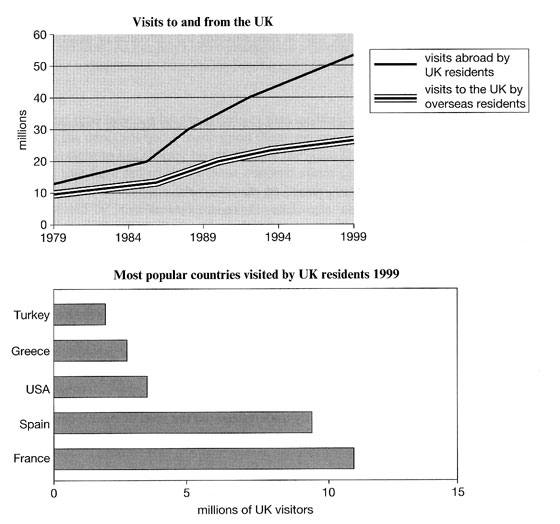
Line and Bar Chart
Visits to and from the UK from 1979 to 1999, and the most popular countries visited by UK residents in 1999.
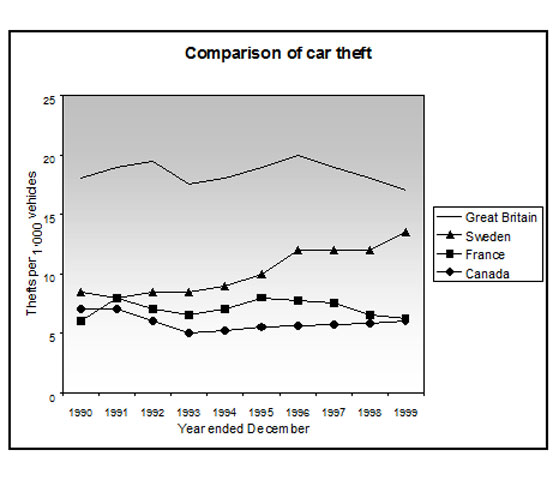
Thefts per thousand vehicles in four countries between 1990 and 1999.
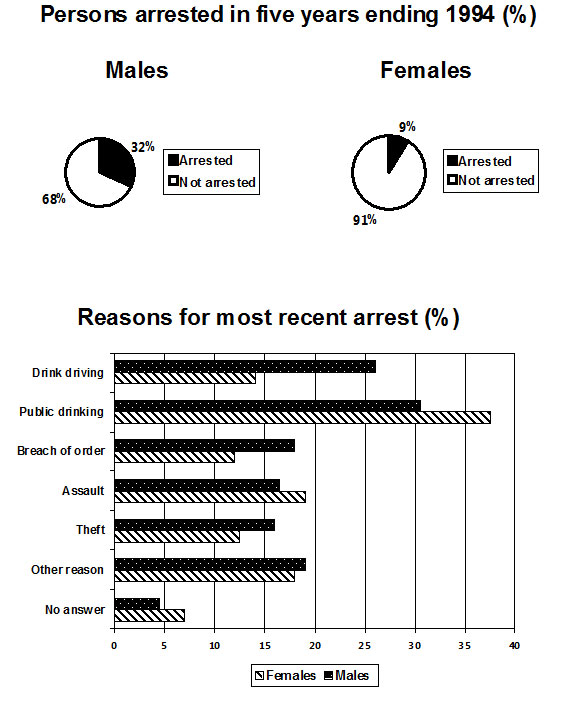
Pie and Bar Chart
The percentage of persons arrested in the five years ending 1994 and the most recent reasons for arrest.
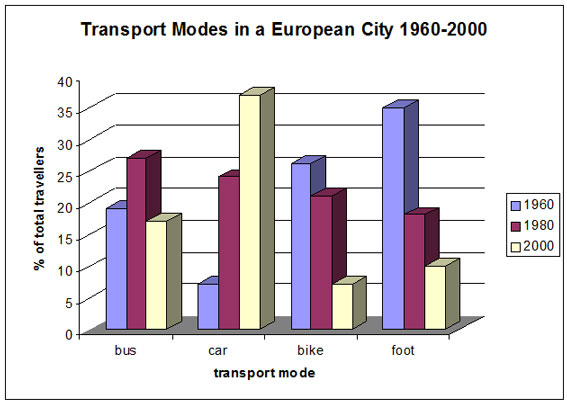
The different modes of transport used to travel to and from work in one European city in 1960, 1980 and 2000.
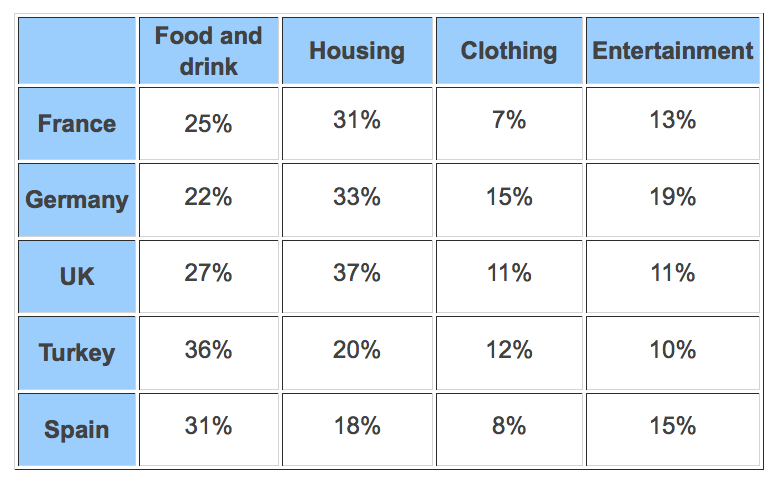
The proportion of monthly household income five European countries spend on food and drink, housing, clothing and entertainment.
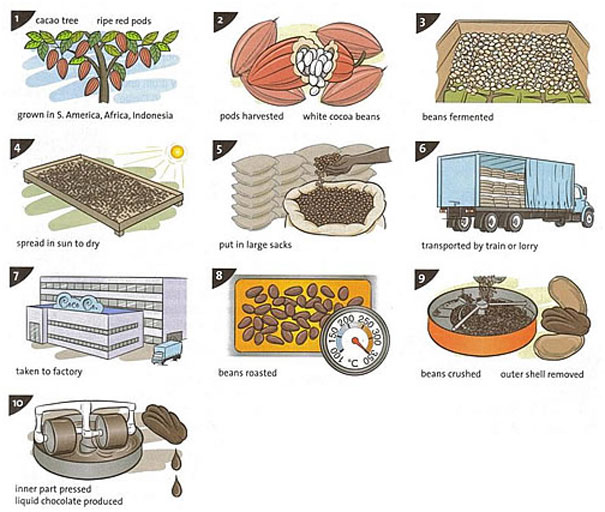
How chocolate is produced.
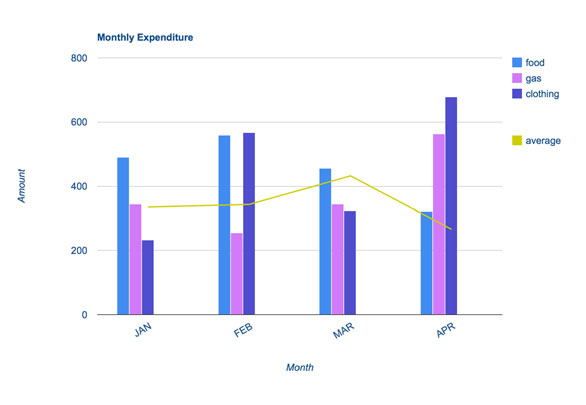
The monthly spending in dollars of a family in the USA on three items in 2010.
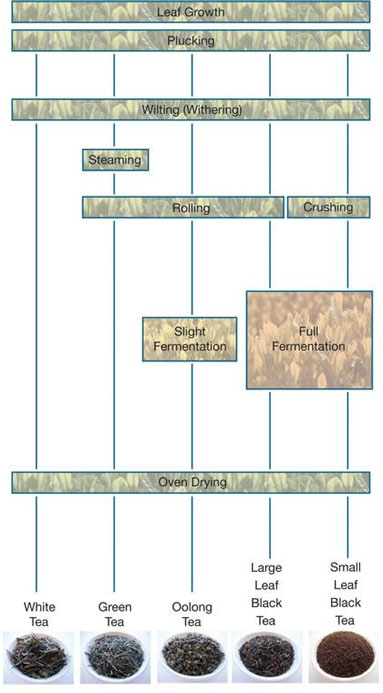
How tea leaves are processed into five tea types.
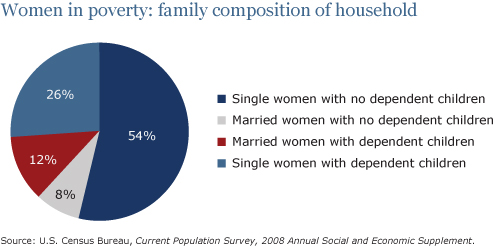
Pie and Bar Chart
The percentage of women in poverty and the poverty rates by sex and age in the United States in 2008.
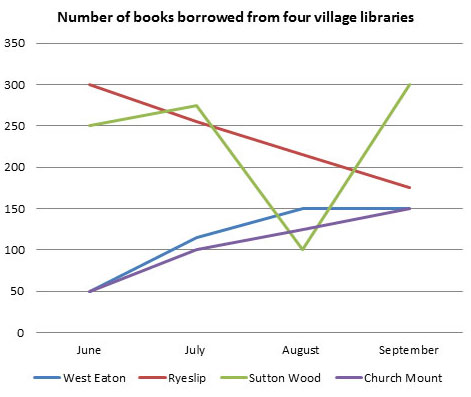
Line and Pie Chart
The number of books that were borrowed in four different months in 2014 from four village libraries, and the pie chart shows the percentage of books, by type, that were borrowed over this time.
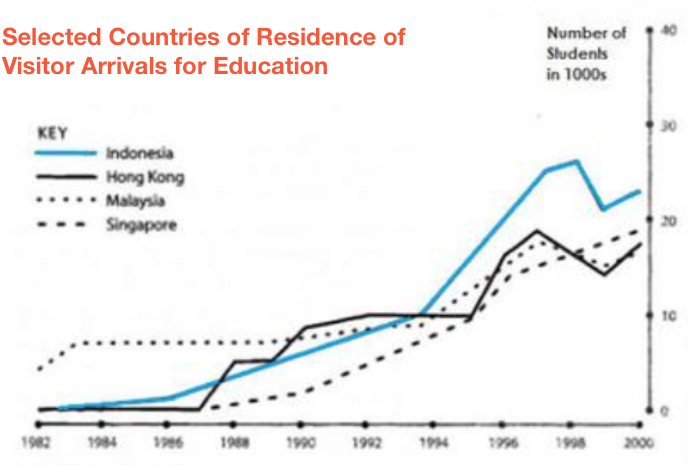
Four countries of residence of overseas students in Australia
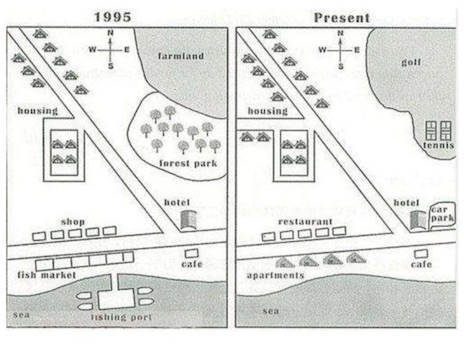
Development of the village of Ryemouth between 1995 and present.
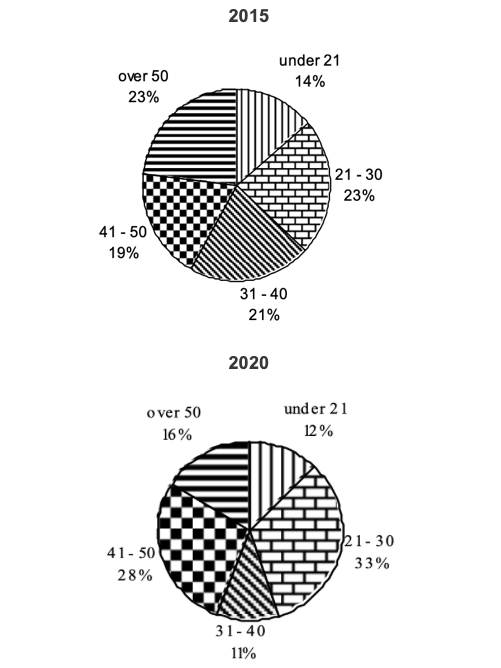
Public Sector Employment in 2015 and 2020.
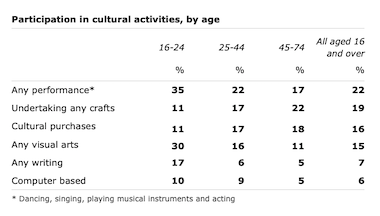
Cultural Activities of Differing Age Groups
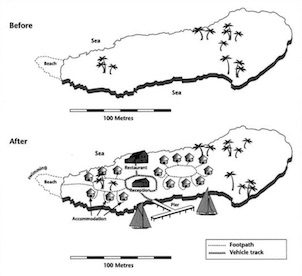
Construction of Tourist Facilities on an island.
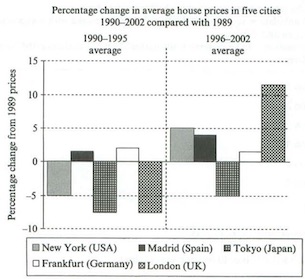
Average House Price Comparison.
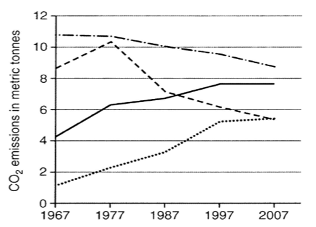
Average carbon dioxide (Co2) emissions per person
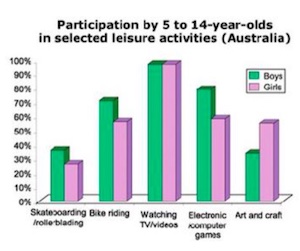
Leisure Activities amongst Australian children.
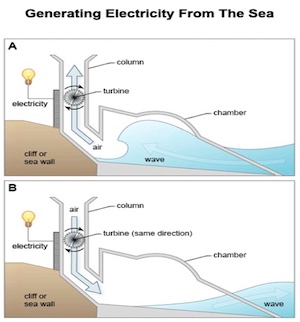
Structure used to generate electricity from wave power.
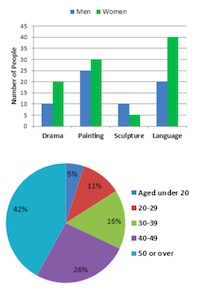
Bar & Pie Chart
Men and women attending various evening courses
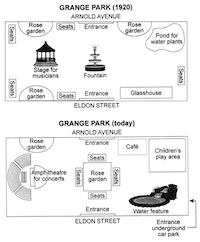
Changes to Grange Park.
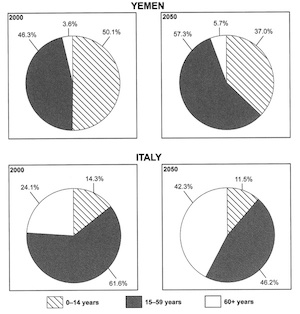
Populations in Yemen and Italy.
Student Sample Graphs
You can also view graphs that have been written by students in the forums:
- Student Graphs
Any comments or questions about this page or about IELTS? Post them here. Your email will not be published or shared.
Before you go...
Check out the ielts buddy band 7+ ebooks & courses.

Would you prefer to share this page with others by linking to it?
- Click on the HTML link code below.
- Copy and paste it, adding a note of your own, into your blog, a Web page, forums, a blog comment, your Facebook account, or anywhere that someone would find this page valuable.
Band 7+ eBooks
"I think these eBooks are FANTASTIC!!! I know that's not academic language, but it's the truth!"
Linda, from Italy, Scored Band 7.5

IELTS Modules:
Other resources:.
- All Lessons
- Band Score Calculator
- Writing Feedback
- Speaking Feedback
- Teacher Resources
- Free Downloads
- Recent Essay Exam Questions
- Books for IELTS Prep
- Useful Links

Recent Articles
Decreasing House Sizes Essay
Apr 06, 24 10:22 AM

Latest IELTS Writing Topics - Recent Exam Questions
Apr 04, 24 02:36 AM

IELTS Essay: English as a Global Language
Apr 03, 24 03:49 PM

Important pages
IELTS Writing IELTS Speaking IELTS Listening IELTS Reading All Lessons Vocabulary Academic Task 1 Academic Task 2 Practice Tests
Connect with us
Copyright © 2022- IELTSbuddy All Rights Reserved
IELTS is a registered trademark of University of Cambridge, the British Council, and IDP Education Australia. This site and its owners are not affiliated, approved or endorsed by the University of Cambridge ESOL, the British Council, and IDP Education Australia.
- Skip to main content
IELTS Podcast
Pass IELTS with expert help.
Academic Writing Task 1 Sample Essays and Answers
Home » IELTS academic task 1 » Academic Writing Task 1 Sample Essays and Answers
This is your very best resource for writing task 1 IELTS academic sample answers.
The resources are organised into different task types so you can look at several IELTS writing task 1 samples for three common diagrams. Read IELTS Writing Task 1 sample answers and questions to learn how you can describe pie charts, bar charts & line graphs.
There may be a lot of IELTS writing task 1 samples (academic) with hints and tips online, but how can you know you are looking at the very best resources? Some of the ‘perfect’ essays online have been written by non-experts, and while they may be useful to you, they should not be taken as a definitive guide to this section of the test.
Improve your IELTS writing and achieve a great band score on the academic paper with these useful links and model answers.
Each sample answer demonstrates the type of writing skills you will need to successfully complete the IELTS writing module for IELTS writing task 1 and IELTS writing task 2.
Take a look at some IELTS academic writing task 1 sample questions with IELTS sample charts to help you prepare for your IELTS exam .
Each bar chart, pie chart and line graph question comes with a sample answer to show you how to describe and compare factual information. This may involve describing differences between monthly spending in two countries over a given period or the number of pupils attending different schools.
You will give an overall perspective and may need to describe an upward trend or a slight difference. There are strategies to help you with each particular graph.
Bar charts – IELTS academic writing task 1 samples with extra hints and tips
Bar chart of international student enrolment in British universities 2009-2014
Bar chart of average monthly revenue from retail telecommunication subscribers
Bar chart of increase in total consumption
Bar chart of life expectancy (2006)
Bar chart of percentage of eligible voters registered for each race by state and year
Bar chart of average weekly attacks
Bar chart of pet Owners
Bar chart showing foreign direct investment in Australia over 3 years
Bar chart describing expected city visits by country of origin for 2018 (thousands/year)
Bar chart IELTS academic task 1 sample essay 15: Average life expectancy per country
Bar chart describing calorie sources for UK males at different life periods. Percentage of total intake.
IELTS academic task 1 sample essay 29: Water service reading
IELTS academic task 1 sample essay 28: Waste hauling truck trips
Bar chart IELTS academic task 1 sample essay 4: Book sales by genre across time
IELTS academic task 1 sample essay 27: Unemployment rate in Asia
Bar chart IELTS academic task 1 sample essay 24: Power consumption (per location) for July 2015
Bar chart IELTS academic task 1 sample essay 23: Passenger served per airport terminal
Bar chart IELTS academic task 1 sample essay 21: Hazardous waste inventory 2014
Bar chart and line graph IELTS academic task 1 sample essay 20: Genset diesel monitoring
Bar chart IELTS academic task 1 sample essay 17: Coastline coverage by country
Bar chart IELTS academic task 1 sample essay 12: 5-year carbon dioxide emission in Japan
Bar chart IELTS academic task 1 sample essay 13: Active military manpower per country
Bar chart IELTS academic task 1 sample essay 9: Toyota car sales – Quarterly monitoring
Writing task 1 pie chart sample answers
Pie chart IELTS academic task 1 sample essay 2: 2014 world food consumption
Pie charts of council expenditure by three regions in the UK, 2014
Pie chart IELTS academic task 1 sample essay 11: 2014 deaths due to neurological condition
Pie chart IELTS academic task 1 sample essay 16: Billing distribution for the month of August 2015
Pie chart IELTS academic task 1 sample essay 18: Daily activity distribution per day
Pie chart IELTS academic task 1 sample essay 3: 2014 age distribution in Asia
Line graphs sample answers for task 1
Take a look at our IELTS writing task 1 line graph examples to help you get a better score for the academic writing task on your IELTS test. IELTS writing task 1 can be challenging but with practice you will get better and better. The resources below include an IELTS writing task 1 sample answer pdf.
Line graph IELTS academic task 1 sample essay 26: Thermal conductivity of material at 25C
Line graph IELTS academic task 1 sample essay 7: January 2015 temperature variation in the Philippines
Line and bar chart IELTS academic task 1 sample essay 5: Common budget items chart
Jump to a band 7 or it’s FREE
Line graph IELTS academic task 1 sample essay 1: Stock market quarterly watch 2014
Line graph IELTS academic task 1 sample essay 25: Production output for 3rd quarter of 2015
Line graph IELTS academic task 1 sample essay 14: Approval ratings of US President Churchill (10-year term)
Line graph IELTS academic task 1 sample essay 8: Temperature calibration data
PDF 30 academic task 1 essays
Line graph IELTS academic task 1 sample essay 22: Income tax comparison per civil status
As well as using the task 1 sample answers above, take a look at our IELTS writing academic task 1 tutorials to help you better prepare for your IELTS exam and achieve a good IELTS writing band score for IELTS writing task 1. There are plans and tips for using tenses and paraphrasing in this writing section and lots of other resources.
Improve your task achievement, use high-level lexis and avoid common grammar mistakes. We’ll help you write the perfect IELTS writing task 1 overview paragraph, make sure you are able to describe the main features of your chart or diagram and give you the lexical resources you need to be successful. It’s important that you look at all the data but select the most important features in IELTS writing task 1.
Why not choose a writing task 1 sample question and try to do it by yourself? Then you can check the model answer for feedback. You probably won’t have time to attempt to write essays for every task 1 sample answer but you will be able to read all the IELTS task 1 writing samples by clicking on the links.
Frequently Asked Questions (FAQ)
How to write ielts writing task 1.
- If you are unsure, re-read some IELTS task 1 sample answers to be clear about the layout you need to use.
- Take 3 -4 minutes to plan what you’re going to write
- Take a step back and see the big picture. Understand what you need to do with that graph, chart, map or diagram in task 1.
- Decide the main points to include.
- Check for any possible comparisons
- Choose your language i.e. words and sentence structures
Read this article for more tips.
Which tense to use in IELTS writing task 1?
This depends on the data in the graph, chart, map or diagram. First, look at the title given and the x and y axes to see if there are any dates used. The writing task 1 academic samples can give you lots of different examples.
- if the year is before the present year (i.e. 1999), use the past tense
- if the year is after the present year (i.e 2020), use the future tense
- if there is no year, use the present simple tense
Read this article for more details and extra writing task 1 samples.
Tutorials for Academic Task 1
- How to get band 9 in task 1
- 5-step plan for task 1
- How to paraphrase in task 1
- Academic task 1 marking criteria
- Five essential writing skills for task 1
- What tense to use in task 1
- How to describe percentages
- Vocabulary to describe a map
- Ebooks & Courses
- Practice Tests
IELTS Academic Writing – How To Plan a Task 1 Essay –
The first step to achieving a high score in IELTS Academic Writing Task 1 is to know how to plan your essay. This is very important and in this lesson, I’m going to explain why and show you how.
The lesson includes:
- 3 reasons why you must plan your essay
- 4 simple steps of essay planning
- 4 part essay structure
- A sample essay written step-by-step
Many students get a far lower score than they’re capable of achieving simply because they either don’t know how to plan their Task 1 essay or they think that planning takes up time that is better spent writing the essay.
Here are three key reasons why you should plan.
3 Reasons Why You Must Plan Your Essay
1) planning saves you time.
If you plan your essay before you start writing, you will already know what you’re going to say and won’t need to keep stopping to think about the next idea. This means that you will be able to write much faster than if you don’t have a plan.
You only need to spend 5 minutes on the planning stage. That leaves 15 minutes to write and check your essay.
2) Planning results in a more relevant answer
25% of your marks are for task achievement. This includes,
- Identifying the main features
- Comparing the main features
- Answering the question appropriately
Planning before you start writing will ensure that you include everything that's required in your IELTS Academic Writing Task 1 essay.
3) Planning results in a better structure
Another 25% of the marks are for coherence and cohesion. This includes,
- Organizing your ideas into a logical order
- Having a separate paragraph for part of the essay
- Linking your paragraphs appropriately
You may have done a fantastic job of identifying the main features of the graphic, and found some great comparisons to write about, but you must also be able to form your ideas into a well-structured essay. Without a plan, this is difficult to achieve. Unless you have a good essay structure, you will not score highly for coherence and cohesion.
Spending a few minutes planning your essay will give you a basic outline to follow as you write. This will make your task a lot easier and lead to a far better essay, and a happy examiner.
The 5 Simple Steps of Task 1 Planning
There are 5 steps to writing a good essay for IELTS Academic Writing Task 1:
- Analyse the question
- Identify the main features
- Write an introduction
- Write an overview
- Write the details paragraphs
We’ll look at these in more detail below but first, I want to outline an easy to remember 4 part essay structure.
The 4 Part Essay Structure
You can use the same basic structure for all IELTS Academic Writing Task 1 questions. Ideally, your essay should have 4 paragraphs:
Paragraph 1 – Introduction
Paragraph 2 – Overview
Paragraph 3 – 1 st main feature
Paragraph 4 – 2 nd main feature
You are only required to write 150 words. You won’t score extra marks for writing a longer essay. It’s what you write that gains you marks.
With only 20 minutes allowed for the task, it’s important that you don’t try to include too many details. Having an essay structure to work with will help you with this. Aim for quality in your essay, not quantity – the right information written in a logical order.
We’re now ready to work through the 5 step planning process.
Planning a Task 1 IELTS Academic Writing Essay
# 1 analyse the question.
The format of every question in IELTS Academic Writing Task 1 is the same.
Here’s a typical question. The highlighted words will always be the same no matter what type of question you get.
The chart below shows the number of men and women in further education in Britain in three periods and whether they were studying full-time or part-time.
Summarise the information by selecting and reporting the main features, and make comparisons where relevant.
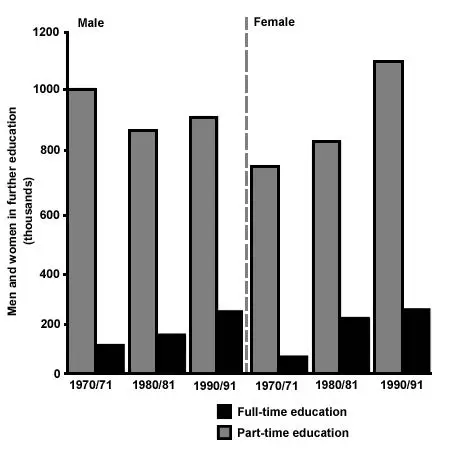
Every question consists of:
- A brief description of the graphic (sentence 1)
- The instructions (sentence 2)
- The graphic – chart, graph, table, etc.
To find out what you have to do, you need to look at the ‘instruction’ sentence.
There are 3 things to do:
1. Select the main features.
2. Write about the main features.
3. Compare the main features.
This is the same for every question and every type of graphic.
Many graphics contain a lot of information. You do not have to write about everything. Just pick out a couple of main features and you’ll have plenty to write about.
# 2 Identify the main features
In this lesson, I’m going to give you a quick overview of how to identify the main features of the graphics. I go into far more detail in the lessons on the individual question types where I work through sample questions step-by-step to create model answers.
Here’s a reminder of the 7 question types . Click the links to go to each page for more planning tips.
- Table Chart
- Process Diagram
- Multiple Graph
I’ve created helpful checklists for identifying the main features of the different types of IELTS Academic Writing Task 1 questions. You’ll find them on this page: How To Understand & Analyse Task 1 Questions
The key features of a graphic will usually be the easiest things to spot.
For a bar chart with a timeline, known as a dynamic bar chart, such as in our sample question, look for general trends. The timeline will give you the biggest clues as to the most significant trends.
Alternatively, a bar chart may be static with the data coming from one point in time. For this type of graphic, you would need to compare whatever different variables are shown. In the in-depth lesson on bar chart essays, for example, you'll see a graph showing the different leisure activities favoured by Canadian boys and girls.
There will be lots of information in the graphic to help you spot the main features. Here are some useful questions to ask for both bar charts and line graphs.
- What information do the 2 axes give?
- What are the units of measurements?
- What can you learn from the title and any labels?
- What are the time periods?
- What is the most obvious trend?
- What are the most notable similarities or differences?

Two general trends in this graphic are:
Main feature 1: the overall number of students in full-time education increases.
Main feature 2: the number of women studying part-time increases steadily but for men, it fluctuates.
The general trends you select will be the starting point for your essay. You will then go on to add more detail.
Let’s look at how to do this. Here’s a reminder of the 4 part structure for IELTS Academic Writing Task 1 essays:
This structure isn’t going be an exact fit for every possible essay but it’s an excellent outline to work from. Use it as a guideline and adapt it as necessary.
First, the introduction.
# 3 Write an introduction (Paragraph 1)
In the introduction, you should paraphrase the question, that is, say the same thing in a different way. You can do this by using synonyms and changing the sentence structure. For example:
The chart below shows the number of men and women in further education in Britain in three periods and whether they were studying full-time or part-time.
Introduction :
The bar graph illustrates how many male and female students were studying full-time and part-time in Britain during the years 1970/1, 1980/1 and 1990/1.
This is all you need to do for the introduction.
# 4 Write an overview (Paragraph 2)
In the second paragraph, you should report the main features you can see in the graph, giving only general information. The detail comes later in the essay. You should also make any clear comparisons you spot.
This is where you write about the general trends. Here are the ones we picked out above.
Now form these ideas into two or three sentences with a total of around 40 words. State the information simply using synonyms where possible. No elaborate vocabulary or grammar structures are required, just the appropriate words and correct verb tenses. For example:
Paragraph 2 :
Overall, the number of students in full-time education increased over this time. With regard to part-time education, there was a steady increase in women choosing to study part-time but for men, the level fluctuated.
# 5 Write the details paragraphs (Paragraphs 3 & 4)
Paragraphs 3 and 4 are where you include more detailed information about the data in the graph. In paragraph 3, you should give evidence to support your first main idea.
In this instance, the data will be numbers of students in the respective time periods. In other graphics, it might be percentages, age, monetary value or some other unit of measurement.
Don’t forget to make comparisons when relevant.
Here’s our first main feature again:
This is an example of what you could write:
Paragraph 3 :
Between the academic periods 1970/1 and 1990/1, the figures for men studying full-time grew in steady increments, beginning at 100,000 in 1970/1 and rising to nearly 300,000 in 1990/1. For women, the numbers had also risen to around 300,000 by 1990/1 on an increasing trend. Notably, however, the figure for females in full-time education in 1970/1 was roughly half that of men, showing a greater take-up than men between 1970/1 and 1980/1.
For the fourth and final paragraph, you do the same thing for your second main feature. For example:
Paragraph 4 :
A different pattern is shown for part-time education. The graph reveals a steady increase in women engaged in part-time study, rising from 750,000 in 1970/1 to 1,000,000 by 1990/1. For men, on the other hand, the figure fluctuated. From 1,000,000 in 1970/1, they had dropped by almost 200,000 by 1980/1 but recovered slightly in numbers by 1990/1. Over the whole time period, the trend between men and women in part-time education reversed, with male students being greater in number in 1970/1 and female students taking pole position by 1990/1.
Here are the four paragraphs brought together to create our finished essay for IELTS Academic Writing Task 1.
Finished essay
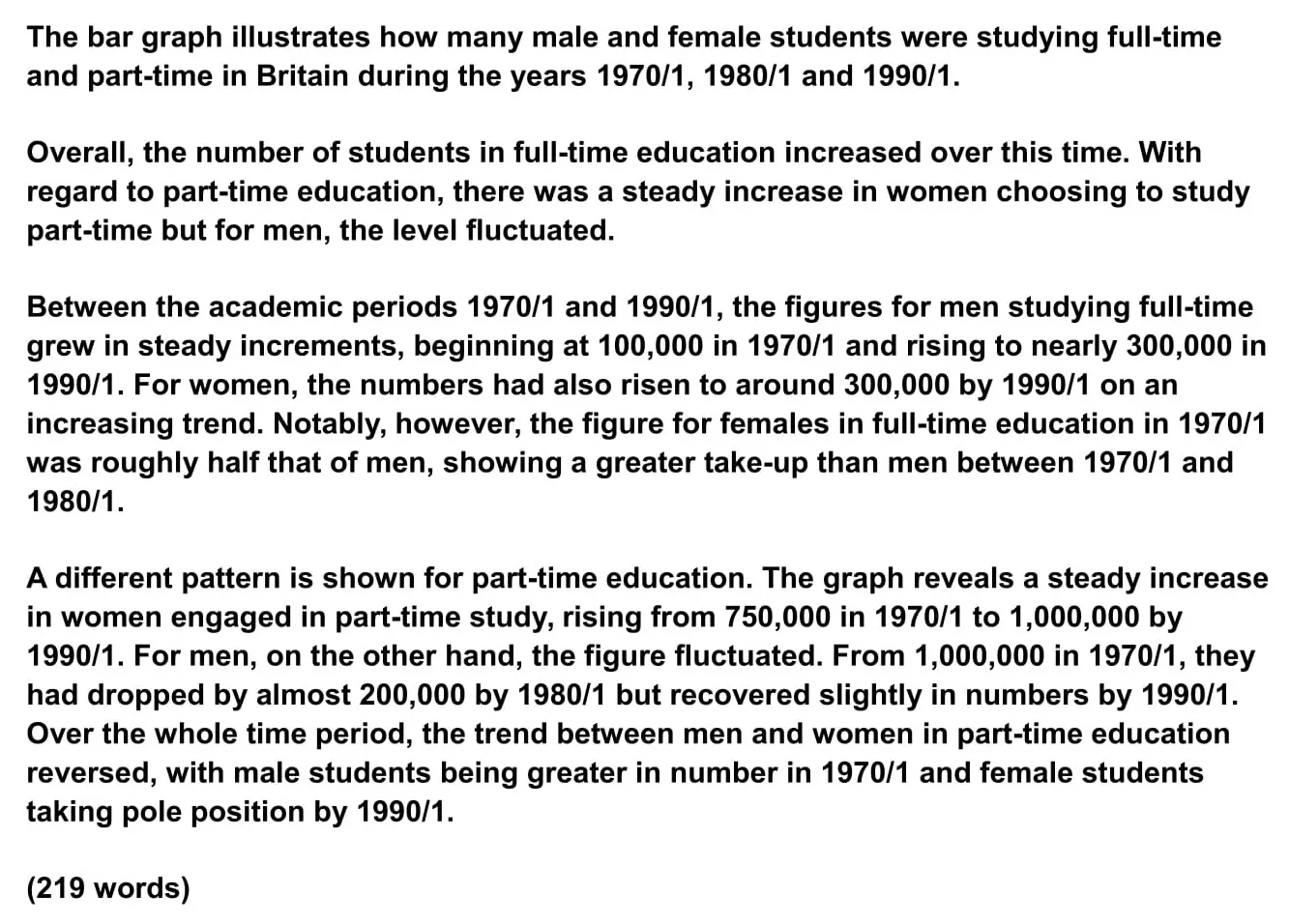
This sample essay is well over the minimum word limit so you can see that you don’t have space to include very much detail at all. That’s why it is essential to select just a couple of main features to write about.
We’ve covered a lot in this lesson. Please don’t feel overwhelmed. Once you start using what you’ve learnt to practice answering IELTS Academic Writing Task 1 questions, you’ll soon be able to plan your essay in 5 minutes.
Want to watch and listen to this lesson on IELTS Academic Writing Task 1?
Click on this video.
Would you prefer to share this page with others by linking to it?
- Click on the HTML link code below.
- Copy and paste it, adding a note of your own, into your blog, a Web page, forums, a blog comment, your Facebook account, or anywhere that someone would find this page valuable.
Like this page?
Ielts academic writing task 1 – all lessons.
IELTS Academic Writing – A summary of the test including important facts, test format & assessment.
Academic Writing Task 1 – The format, the 7 question types & sample questions, assessment & marking criteria. All the key information you need to know.
Understanding Task 1 Questions – How to quickly and easily analyse and understand IELTS Writing Task 2 questions.
How To Plan a Task 1 Essay – Discover 3 reasons why you must plan, the 4 simple steps of essay planning and learn a simple 4 part essay structure.
Vocabulary for Task 1 Essays – Learn key vocabulary for a high-scoring essay. Word lists & a downloadable PDF.
Grammar for Task 1 Essays – Essential grammar for Task 1 Academic essays including, verb tenses, key sentence structures, articles & prepositions.
The 7 Question Types:
Click the links below for a step-by-step lesson on each type of Task 1 question.
- Multiple Graphs
- IELTS Writing
- How To Plan a Task 1 Essay
- Back To Top
* New * Grammar For IELTS Ebooks

$9.99 each Full Set Just $ 23.97
Find Out More >>
IELTS Courses

Full details...

IELTS Writing Ebook

Discount Offer
$7 each Full Set Just $ 21

Find out more >>
Testimonials
“I am very excited to have found such fabulous and detailed content. I commend your good work.” Jose M.
“Thanks for the amazing videos. These are ‘to the point’, short videos, beautifully explained with practical examples." Adari J.
"Hi Jacky, I bought a listening book from you this morning. You know what? I’m 100% satisfied. It’s super helpful. If I’d had the chance to read this book 7 years ago, my job would be very different now." Loi H.
"Hi Jacky, I recently got my IELTS results and I was pleased to discover that I got an 8.5 score. I'm firmly convinced your website and your videos played a strategic role in my preparation. I was able to improve my writing skills thanks to the effective method you provide. I also only relied on your tips regarding the reading section and I was able to get a 9! Thank you very much." Giano
“After listening to your videos, I knew I had to ditch every other IELTS tutor I'd been listening to. Your explanations are clear and easy to understand. Anyways, I took the test a few weeks ago and my result came back: Speaking 7, listening 9, Reading 8.5 and Writing 7 with an average band score of 8. Thanks, IELTS Jacky." Laide Z.
Contact
About Me
Site Map
Privacy Policy
Disclaimer
IELTS changes lives.
Let's work together so it changes yours too.
Copyright © 2024 IELT Jacky
All Right Reserved
IELTS is a registered trademark of the University of Cambridge, the British Council, and IDP Education Australia. This site and its owners are not affiliated, approved or endorsed by the University of Cambridge ESOL, the British Council, and IDP Education Australia.


IELTS Writing Task 1

The IELTS academic exam writing task 1 consists of 6 types of charts such as process diagrams, maps , bar charts , pie charts , tables, or line graphs . You will need to write a report about one of these, but remember it is very different to writing task 2, it is not an ‘essay’ it is a factual report.
In academic task 1, there must be an overview and a factual description of the main parts of the task, no opinion is given, and do not write a conclusion for this type of task. This part of the test is worth one-third of your marks for the writing section, writing task 2 is worth much more in marks.
You only have about 20 minutes to complete writing task 1. For tips and advice on word count in task 1 writing click this link here to find out more.
IELTS General Writing Task 1 Lessons
Guide to IELTS academic and general writing task 1
How to write an informal letter in IELTS General
How to write a formal letter in IELTS General
Model answer for a formal letter: Job application
Model answer for an informal letter: Selling a Laptop
Model answer for an informal letter: Letter to a friend about a problem at work
Model answer for an informal letter: Letter to a friend about doing exercise
Model answer for a formal letter: Asking your boss for time off
IELTS Academic Writing Task 1 Lessons
Grammar and vocabulary:.
Academic writing task 1 vocabulary: ‘number, amount, figure, total, accounted for’
Using vocabulary accurately to report on figures in writing task 1.
Vocabulary and grammar for describing trends.
Paraphrasing statistics.
How to use prepositions accurately.
Model Answer: Present-future maps IELTS 17, Norbiton town
Model answer: Floor plan lesson with grammar and analysis.
Model answer: 2 Maps with key grammar and vocabulary .
Model answer: 3 Diagrams/maps with model and analysis.
Model answer: 2 maps of a park layout with model answer and tips.
Process Diagrams:
Model answer: How instant noodles are manufactured.
Model answer: How geothermal energy produces electricity
Model answer and grammar: The process of making dairy products.
Model answer and analysis: Recycling process of aluminium drinks cans.
Model answer: Natural process diagram on the lifecycle of a honey bee.
Bar charts:
Model answer and analysis: IELTS 18 bar graph on household income in the USA.
Model answer: Coffee and tea drinking habits in Australia (making comparisons)
Model answer and analysis: Fast food restaurants in the USA bar graph.
Model answer: Bar graph about passengers using public transport.
Model answer and analysis: UK telephone calls bar chart .
Line graphs:
IELTS 17 book: model answer about shop openings and closures.
Model answer and analysis: CO2 emissions in four different countries.
How to write about line graphs with a future trend.
Line graph with a future trend: US energy consumption by fuel source (model answer).
Pie Charts:
Two model answers: 3 pie charts making comparisons about 4 types of nutrients.
Model answer: Pie chart and table about postgraduate students.
Model answer: Visitors to a museum, 2 pie charts with a table and exercise.
Model answer: Fuel sources in France, two pie charts.
Model answer and analysis: Underground railways in 6 cities.
Model answer and analysis: Consumer spending in 5 different countries.
Model answer: Factory workers table with dynamic data.
1. Line Graph

2. Pie Charts

3. Process Diagram

5. Bar Chart

Struggling to get band 7 in writing ?.. Check out the writing correction service here

Press ESC to close

How Many Types of Writing Task 1 are there in IELTS? Study for Getting the Best Marks in Your Exam
An IELTS Preparation usually requires an individual a total of 60 minutes to complete. But there are basically two tasks in the IELTS exam – Task 1 and Task 2. Out of these two tasks, the first task requires an individual a total of 20 minutes to complete. On the other hand, task 2 of the IELTS exam requires an individual a total of 150 minutes to complete.
Today, we’ll be talking about task 1 of the IELTS exam which will just require you 20 minutes to complete, thus a preparation for the shorter period of time as compared to the second task.
Let’s first learn about what an IELTS exam is?
Also Read: Does the IELTS Essay Question Repeat? Here’s all about the IELTS Writing Task 2
What is an IELTS Exam?
IELTS, also known as the International English Language Testing System, is a test of the English language proficiency of an individual that he/she has to go through when they have decided to either live, study, or shift abroad permanently or on a temporary basis.
English is one of the world’s most popular and respected languages in the entire world that is used for the education and migration of an individual.
Any individual who has decided to apply for the IELTS exam has to go through various phases of the exam and test their abilities for the exam in four different categories. These are:
Now, let’s turn towards focusing on learning about the two types of tests. The writing tasks explained are as follows:
Types of Writing Task in IELTS
The IELTS Writing Task is an essay that requires an individual to write, both for the academic as well as the general tests. You, as an individual would be provided with a topic that you’re supposed to write a minimum of 250 words upon.
There are five main types of essay questions being asked in the Writing task of an IELTS exam. These are:
- Opinion Essay
- Discussion Essay
- Problem Solution Essay
- Advantages and Disadvantages Essay
- Double Question Essay
Most of the questions being asked in this exam can be written in so many different ways that make it difficult for an individual to determine the type of this exam. A basic structure for answering the questions in the IELTS exam could be like:
- Introduction
- Main Body Paragraph One
- Main Body Paragraph Two
Now, let’s turn towards learning about task one of this paper.
Also Read: Which Tense to Use in IELTS Writing Task 2? Learn How to Write a Perfect Essay
How Many Types of Writing Task 1 in IELTS?
In an IELTS Writing Task One, the types of questions being asked can be in the form of:
- Diagram or Process
- Combination of all the above, i.e., Multiple Tasks
And to prepare for all of them, it requires an individual to go through a lot of hard work. So, now, let’s check out how you can improve your scores in the Writing Task One of this paper that would help you to fulfil your dreams of studying abroad.

Tips & Tricks to Improve Your Scores for the IELTS Writing Task One
Given below are a few steps that can help you to improve your scores for the IELTS Writing Task One:
Analyse Before Writing
This is one of the biggest mistakes that people usually do when they are appearing for the exam, which is – Analyzing the question. By not analyzing the question correctly, you would be missing out on some of the important key features of the paper that can be extremely important for you to get a minimum of score of 7 as the band score of the IELTS exam. For example, if there’s a question describing a bar chart in the paper, all you’re required to do is study the question properly before answering it so that you can write a perfect answer in the exam.
Mention Only the Important Features
There is always a mistake done by students when they are writing the answers in an exam and that is to mention all the details in a question. So, instead of beating around the bush, why not just focus on the important aspects of the question that can help you to save your time as well. For example – Percentage of children interested in Science subject is 50 in the year 1990 which increased to 60 in 2000 and then again there was an increase in the percentage to 70 in 2010. Afterwards, it would be raised to 80% in the year 2020. Rather than writing all the details as above, first, the trend should be analyzed to be described as below: It can be observed from the graph that interest of children towards Science subject is increasing consistently (50% in 1990 to 80% in 2020) by 10%.
Paraphrase, Compare, and Contrast
One of the most important skills that an individual is required to perform while answering the question and is to paraphrase the information given in the question. You can do a lot of things while answering the questions: Use synonyms, Change the word order, Convert the active statements into passive statements, Do not copy the question.
Proofreading
Reviewing at the end is extremely essential because that can help you to find a lot of mistakes in your writing. This can help you to make a big difference in your writing. The one which was earlier full of mistakes of grammar, punctuation, tenses, and other spelling mistakes can now be free of it once you’re done proofreading it.
Each section is important when you are planning to achieve the desired score, which can help you to open gates for studying abroad. The IELTS test is used as a selection criterion in which an individual is required to get into your desired country and university.
The above piece of information provides you with several details related to the IELTS exam.
Hopefully, you must have found this information useful and if you have any doubts regarding the same, feel free to use the comments section below and share your problems, queries, as well as questions with us to help us know more about it because we’ll be more than happy to help you out through this.
Also, check out our other blogs for getting more such information related to the IELTS exam that will help you to further fulfil your dreams and achieve several heights in the future.

Leave a Reply Cancel reply

Share Article:
About the Author
Sakshi bachani.
Sakshi Bachani is a freelance Content Writer and Teacher. She has completed her Bachelor's degree from Delhi University.. She has been a freelance teacher for the past five years and has worked towards helping young kids achieve their dreams. She had also worked as an Intern teacher with an NGO. Apart from writing and teaching, she really enjoys music, animals, and plants. She even has her own little garden which she loves very dearly and can be sometimes seen buying more plants for herself.
You might also like

Describe Something Important that has been Kept in Your Family: A Cue Card Sample Topic for IELTS Speaking

How to Use an IELTS Calculator? Calculate Your Overall IELTS Exam Score

What is a Good IELTS Score? Is 7.5 a Good IELTS Score? Here’s All You Need to Know
Other stories, how many idioms and phrases are there in english get all your doubts cleared here, the difference between idioms and phrases and proverbs: the most known topics for ielts.
IELTS Academic Writing Task 1 – Sample Answers
Here are a number of writing task 1 sample essays for you to look at. Take a look through the questions and sample answers and compare them to your own work. Are they similar? Do you find them easy to understand? Do they answer the question? Can you see how the information has been structured?
It is important for you to look at sample essays when you are studying to see if your work is on the way to becoming a band score 7 or higher.
Read through the essay feedback and see why the essays have achieved a band score 9 . The band 9 criteria are also at the end of this post.
Sample Essay 1 – Pie Charts
The pie charts show the ratio of goods shipped from Great Britain from 2010 to 2015. The products are measured by percentage.
Overall, over the five-year period, the most exported goods were machinery and vehicles. These two types of goods were predominantly wanted out of all of the categories. The least amounts of goods exported were plastics and organic chemicals. Minimal changes occurred over the selected time period.
On the one hand, machinery exports have a small increase as the amounts moved are 29% and 30% respectively. The percentage of vehicles shipped only rose slightly by 1% from 2010 (28%) to 2015 (29%). The machinery and vehicles export pattern remained steady throughout the five years.
On the other hand, the diagrams illustrate an increasing rise in the production of plastics at over 4% since 2010. Furthermore, the most relevant feature is the increase in the export of organic chemicals from 2010 (7%) to 2015 (10%). There is a huge difference in the production of pharmaceuticals, due to the fact that it experienced a decrease from 2010 (27%) to 2015 (18%).
(Word Count = 180 / Band Score 9)

- Task Achievement – The answer provides a paraphrased question, to begin with, followed by an overview that gives the reader key information. The information selected is relevant.
- Coherence and Cohesion – The answer has been divided into clear logical paragraphs.
- Lexical Resource – There is evidence of paraphrasing, synonyms and some less common words.
- Grammatical Range and Accuracy – The answer has no grammatical errors. The sentences are mainly made up of multiple clauses and have a variety of structures.
TIP >> Remember to identify two or three main features and write about those. You don’t need to write about everything you see in order to gain a high band score.
Sample Essay 2 – Line Graph Showing Future Trends
The line graph presented depicts the loan status of the Royal Bank of Scotland between the years 2012 to 2022. It is measured in millions of pounds sterling.
Overall, it can be seen that while student loans and mortgages are predicted to increase simultaneously over the period, auto loans and personal loans have highs and lows, therefore remaining much lower in comparison.
Firstly, it is clear that student loans and mortgages are following a very similar pattern over the years. Student loans stood at just under 1.500 million in 2012, noticeably, being the highest of the four groups. Though they remained constant up to 2013, they are expected to climb steadily to approximately 2.5 billion in 2022. Like the student loans, mortgages are predicted to follow a similar pattern and increase.
Secondly, auto loans are expected to show abnormalities of both highs and lows during the years. Although having initially grown, they will drop to 700 million in 2016, before reaching the peak of about 1500 million in 2020. Auto loans will end close to the amount where they began.
Finally, personal loans were staged at the lowest level of the four groups, at under 500 million in 2012. Despite climbing up and overtaking auto loans briefly in 2016 to about 800 million, this level will continue decreasing until 2022 to 400 million.
(Word Count = 223 / Band Score 9)
- Task Achievement – The answer provides a paraphrased question, to begin with, followed by an overview that gives the reader key information. The final sentence has a future prediction.
- Coherence and Cohesion – The answer has been divided into clear logical paragraphs. The overview explains the trends generally then the specific information is written about in the main body paragraphs.
- Lexical Resource – There is evidence of paraphrasing, synonyms and some less common words. Specific vocabulary used to describe change over time has been used.
- Grammatical Range and Accuracy – The answer has no grammatical errors. The sentences have a variety of structures.
TIP >> Remember to end the essay with a prediction for the future , after looking at the present.
Sample Essay 3 – Process
The illustration shows the whole process of how a hydroelectric dam manufactures electricity from water.
Overall the main element of the procedure is the flow of water, making a reservoir of water, this is the first step until the last step where the power is produced and distributed. There are 5 main steps in this process.
To begin, a body of water is stored in a large water reservoir holding the water until it goes into the intake. The dam will then control the flow of water to the intake. After that, water will flow to a cylindrical passage called a penstock, making it flow with a strong pressure until it reaches the turbine. Next, the current of the flowing water from the river passing through the penstock will maintain the turbine’s rotation.
Subsequently, the rotation of the turbine would produce energy that will pass through a generator until electricity is produced. The generator is inside of the powerhouse, where long distance power lines are connected. Finally, from the generator, electricity is then transmitted to long distance power lines.
(Word Count = 178 / Band Score 9)
- Task Achievement – The answer provides relevant information, describing the process through every stage. The overview gives clear information, leading into the main body paragraphs.
- Coherence and Cohesion – The answer has been divided into clear logical paragraphs, with clear cohesion between them with the addition of time connectors (after that, next, subsequently, finally).
- Lexical Resource – There is evidence of paraphrasing, synonyms and some less common words.
- Grammatical Range and Accuracy – The answer has no grammatical errors. The sentences are mainly made up of multiple clauses and have a variety of structures. There are no spelling mistakes and punctuation is correct.
TIP >> Write a good overview , with how many stages the process has, starting with….. and ending with……then go into the main detail of describing the process into the main body paragraphs.
TIP >> Describe the process and lead the reader through it by using time connectors.
Sample Essay 4 – Line Graph
The line graph illustrates the climate conditions in Athens, Barcelona, and Sydney over the period of one year.
Overall, it can be seen that generally, the cities of Athens and Barcelona have a similar temperature movement in comparison with Sydney. Both Athens and Barcelona’s temperatures peak during the summer months of June, July and August, while Sydney has lower temperatures during those three months. In contrast, Sydney’s highest temperatures are when Athens and Barcelona have their lowest.
To begin with, Athens has approximately 8 degrees of temperature in January with a gradual increase to 25 degrees in June. However, this trend slowly declined each month reaching close to 8 degrees by December. Similarly, Barcelona had a similar trend but started with just a little below 7 degrees in January. Nonetheless, after the succeeding months, there had been a steep incline to the temperature that peaked at around 28 degrees in August. But, a sudden drop to nearly 5 degrees per month was experienced for the remaining months until December with exact 6 degrees.
In contrast to Athens and Barcelona, Sydney’s temperature was just a little over 27 degrees in January but slowly decreased in the following months, reaching the lowest point at 14 degrees in July. Finally, this average monthly temperature incrementally increased each month, ending with the same temperature of 25 degrees in December.
(Word Count = 225 / Band Score 9)
- Task Achievement – The answer provides a paraphrased question, to begin with, followed by an overview that gives the reader key information.
- Coherence and Cohesion – The answer has been divided into clear logical paragraphs. The overview explains the trends generally, then the specific information is written about in the main body paragraphs.
TIP >> Remember to compare and contrast information, using cohesive devices , such as overall, to begin with, similarly and finally.
Sample Essay 5 – Table
The table illustrates the percentage of people who decided to shop in a humane way from 2012 to 2014.
Overall, it is evident that the free range/organic and fairtrade experienced declines in numbers of shoppers, whereas the pre-loved clothes became the most wanted items during the same period.
To begin, the proportion of people buying ethical clothing fell from just over half to only 20% or one fifth from 2012 to 2014. Similarly, the relative number of people buying Fairtrade items — just under one quarter — dropped by half in the same period. As for the free range and organic products, the relatively small percentage of people buying this type of product in 2012 (12%) also fell, although not significantly.
However, while the other three types of ethical shopping declined in importance, the opposite was true in the case of pre-loved clothes. In fact, while only a small minority of 12% were interested in purchasing these in 2012, this figure increased to well over half of all shoppers during the following two years reaching 58% in 2014.
- Task Achievement – The answer provides a paraphrased question, to begin with, followed by an overview that gives the reader key information that is supported by data from the table.
TIP >> Remember to highlight any trends that stand out , for example in this table, the number of people buying pre-loved clothes in 2014.
Writing Task 1 Band Score 9 Criteria >>
Ielts writing task 2 question types.
Agree/Disagree Essays ADVANTAGE / DISADVANTAGE ESSAY CAUSE AND EFFECT ESSAY IELTS Problem/Solution Essay IELTS Discussion Essay POSITIVE OR NEGATIVE ESSAY Direct Question Essay IELTS Writing Task 2 Student Essay
We hope you found this post useful in helping you to study for the IELTS Test . If you have any questions please let us know in the comments below or on the Facebook page.
The best way to keep up to date with posts like this is to like us on Facebook , then follow us on Instagram and Pinterest .
If you need help preparing for the IELTS Test, join the IELTS Achieve Academy and see how we can assist you to achieve your desired band score. We offer an essay correction service, mock exams and online courses.
Related Posts
![task 1 essay types You are not happy with the course you are doing at college and would like to change to a different course: Semi-Formal Letter [IELTS General Writing Task 1 ]](https://www.ieltsachieve.com/wp-content/uploads/2023/08/You-are-not-happy-with-the-course-you-are-doing-at-college-and-would-like-to-change-to-a-different-course.png)
You are not happy with the course you are doing at college and would like to change to a different course: Semi-Formal Letter [IELTS General Writing Task 1 ]
You should spend about 20 minutes on this task. You are not happy with the…
![task 1 essay types You live in a flat and you have a tenancy agreement- IELTS General Writing Task 1 [Semi-Formal Letter]](https://www.ieltsachieve.com/wp-content/uploads/2023/08/You-live-in-a-flat-and-you-have-a-tenancy-agreement.png)
You live in a flat and you have a tenancy agreement- IELTS General Writing Task 1 [Semi-Formal Letter]
You should spend about 20 minutes on this task. You live in a flat and…
Leave a Comment Cancel Reply
Your email address will not be published. Required fields are marked *
Save my name, email, and website in this browser for the next time I comment.

IMAGES
VIDEO
COMMENTS
This is important to know because understanding task 1 puts you in a good position to succeed at it. Now, let's look at the different IELTS writing task 1 types. 1. Line Graphs. Probably the most common type of IELTS writing task 1 data is a line graph. As a result, many textbooks, teachers, courses, and classes focus on teaching this above ...
Paradise Island Map - IELTS Academic Writing Task 1 Answers. IELTS Academic Writing Task 1 Example 4 : Development of the village of Rye mouth - Map. IELTS Academic Writing Task 1 Topic: The development of cutting tools in the stone age - Diagram. IELTS Academic Writing Task 1 Example 3: Civic Centre - Map.
This comprehensive guide breaks down the different question types in the Writing Task 1 section, including graphs, bar charts, pie charts, tables, and maps. In the IELTS Writing test, there are a variety of question types you can receive. It is important to have a look at these so you don't have any surprises when you sit your test.
Grammar for Task 1 Essays - Essential grammar for Task 1 Academic essays including, verb tenses, key sentence structures, articles & prepositions. The 7 Question Types: Click the links below for a step-by-step lesson on each type of Task 1 question.
People doing the Academic test will write a report on a data set, map, or process. People doing General Training will write a letter. You must write 150 words or more. You should spend around 20 minutes on this part of the test. Task 1 is worth 1/3 of your total mark on the Writing test.
Task 2 is a standard five-paragraph essay in which you present your perspective on an issue. Task 2 is worth more points than Task 1, and Task 2 requires more time to complete. Therefore, you may be tempted to brush aside IELTS Academic Writing Task 1 as you study, choosing instead to focus much more attention on Task 2.
1. The type of data - chart, table, map, process etc. 2. Other key information e.g. where, when, what You should read this sentence carefully as you will need to paraphrase this information when you write an introduction to your task 1 essay. The Data - 6 Task Types The data is the information you have to describe in your task 1 essay.
A Complete Guide on IELTS Academic Writing Task 1. In Academic Writing Task 1, you will be given one or multiple diagrams that can be in many forms such as, graphs, pictures, data tables etc. You will be asked to write an essay on the given diagrams. You will need to write at least 150 words for this essay.
You should write over 150 words. IELTS writing task 1 is worth only about 33% of your total writing marks. Academic writing task 1 is a report on a chart (bar chart, line graph, pie chart, table, map, diagram/process). See below for practice charts, model answers, tips etc. General Training writing task 1 is a letter only.
Academic writing task 1 requires that you summarise and compare a diagram, chart or graph, talking about the main features. You should use at least 150 words for the task. This section is not an essay. It is a summary. You should use formal language and it must factual.
Types of Task 1. Learn the 6 main types of charts that can be given in writing task 1 (maps, diagrams, bar charts, tables, line graphs and pie charts). ... However, writing task 1 is not an essay, it is a report. Paragraphs are not balanced in length. It is even possible to have a paragraph of one sentence. It's fine for teachers to advise ...
The guide tells you everything you need to know about how Writing Task 1 essays and paragraphs should be structured, with an example question and model essay. IELTS Writing Task 1 Samples: The Major Question Types. Below are questions for each common infographic in IELTS Writing Task 1: bar charts, pie charts, line graphs, process diagrams, and ...
Read my sample answer for this (unusual) task 1 here. IELTS Essay: Bridges. Read my sample answer for this topic here. The bar graph shows the total manufacturing production in percentages Asia, Europe, and the rest of the world. IELTS Task 1 Reported on May 7th. Read my sample answer here. Reported on IELTS May 1st. Read my sample answer here.
Types of IELTS Academic Writing Task 1 Question. Here are all of the different IELTS Academic Writing Task 1 question types you need to know: 1. Describing a Line Graph. Line graphs are used to show trends or changes over time. Source: ielts-writing.info. Analysis :
Here you will find IELTS Writing Task 1 Samples for a variety of common tasks that appear in the writing exam. The model answers all have tips and strategies for how you may approach the question and comments on the sample answer. It's a great way to help you to prepare for the test.
The resources below include an IELTS writing task 1 sample answer pdf. Line graph IELTS academic task 1 sample essay 26: Thermal conductivity of material at 25C. Line graph IELTS academic task 1 sample essay 7: January 2015 temperature variation in the Philippines. Line and bar chart IELTS academic task 1 sample essay 5: Common budget items chart.
Writing IELTS Task 1 (Academic) - All Lessons IELTS Academic Writing - A summary of the test including important facts, test format & assessment.. Academic Writing Task 1 - The format, the 7 question types & sample questions, assessment & marking criteria. All the key information you need to know. Understanding Task 1 Questions - How to quickly and easily analyse and understand IELTS ...
Two general trends in this graphic are: Main feature 1: the overall number of students in full-time education increases. Main feature 2: the number of women studying part-time increases steadily but for men, it fluctuates. The general trends you select will be the starting point for your essay.
Academic task 1 is 33% of your overall IELTS writing band. So, out of the complete one hour you get for the writing exam, you should not spend more than 20 minutes on this task. Also, the minimum word limit for task one is 150 words. Task one is formal and factual, so try to avoid any word contractions, do not give your opinion or any ...
The IELTS academic exam writing task 1 consists of 6 types of charts such as process diagrams, maps, bar charts, pie charts, tables, or line graphs. You will need to write a report about one of these, but remember it is very different to writing task 2, it is not an 'essay' it is a factual report. In academic task 1, there must be an ...
Study for Getting the Best Marks in Your Exam. An IELTS Preparation usually requires an individual a total of 60 minutes to complete. But there are basically two tasks in the IELTS exam - Task 1 and Task 2. Out of these two tasks, the first task requires an individual a total of 20 minutes to complete. On the other hand, task 2 of the IELTS ...
Sample Essay 1 - Pie Charts. The pie charts show the ratio of goods shipped from Great Britain from 2010 to 2015. The products are measured by percentage. Overall, over the five-year period, the most exported goods were machinery and vehicles. These two types of goods were predominantly wanted out of all of the categories.